Accton Technology 7404WBRAACC Wireless ADSL Barricade, Wireless ADSL Router User Manual 00 us
Accton Technology Corp Wireless ADSL Barricade, Wireless ADSL Router 00 us
Contents
- 1. User Manual Part 1
- 2. User Manual Part 2
- 3. User Manual Part 3
- 4. User Manual Part 4
User Manual Part 1
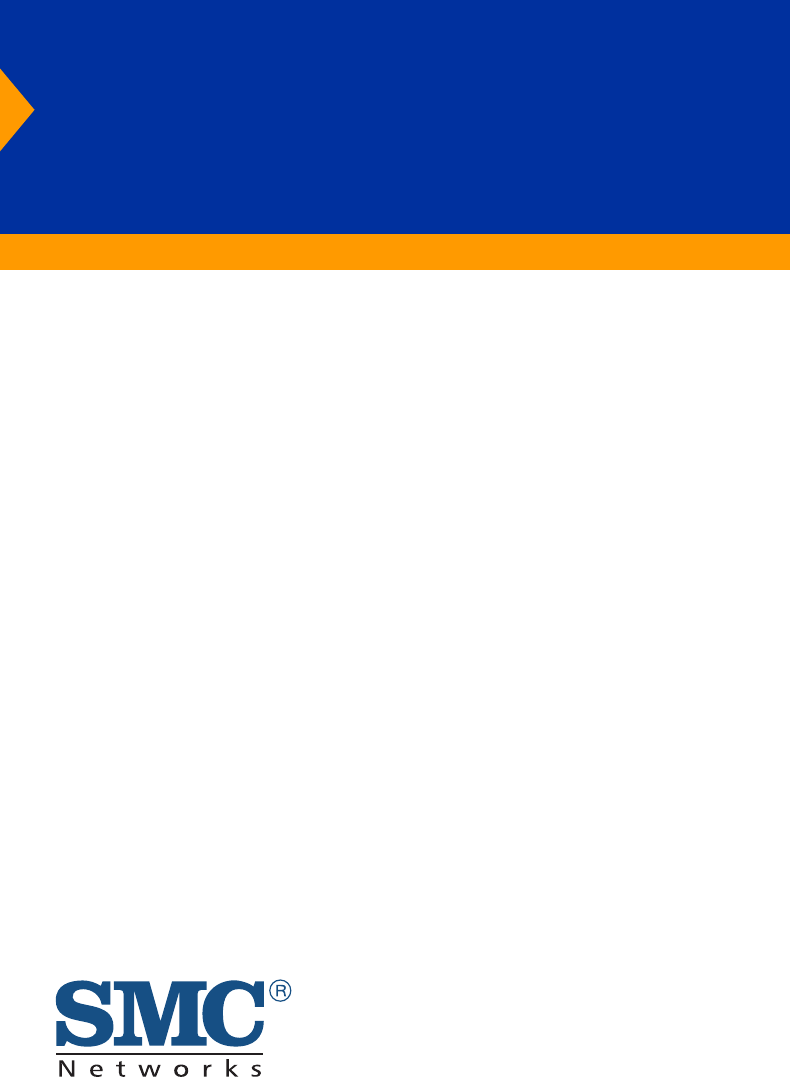
Barricade ADSL Router
Wireless Broadband Router with
built-in ADSL Modem
◆ Compatible with all leading DSLAMs
◆ Firewall (hacker attack logging, DoS, and client filtering)
◆ Supports DMT line modulation
◆ Four auto-negotiating 10/100 Ethernet ports
◆ Built-in print server
◆ PPTP, L2TP, and IPSec pass through
◆ Multiple user Internet access with a single-user account
◆ Supports PPPoE and PPPoA
◆ Plug & Play installation
◆ Web-based management
User Guide
SMC7404WBRA
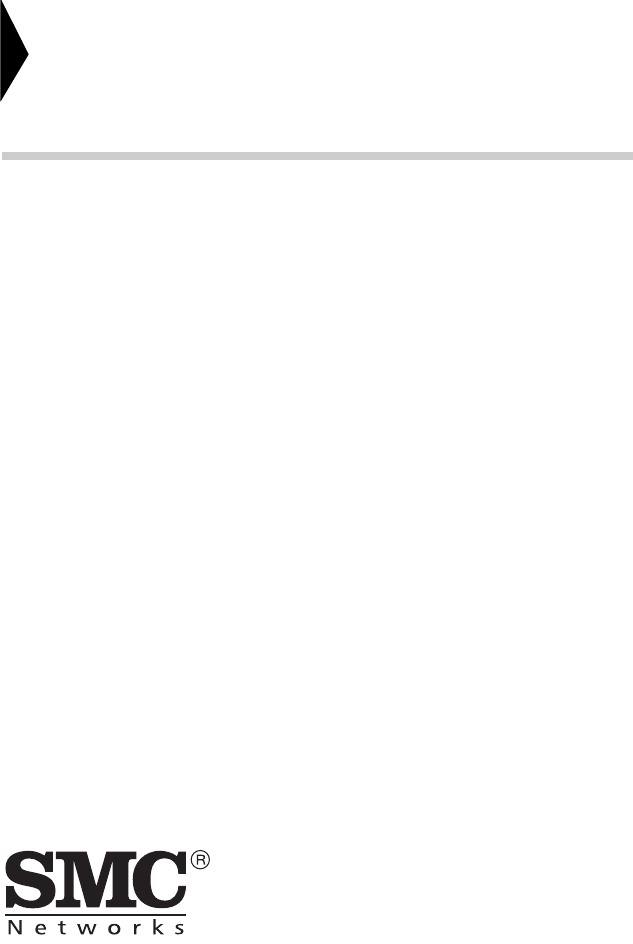
38 Tesla
Irvine, CA 92618
Phone: (949) 679-8000
Wireless Broadband Router
with built-in ADSL Modem
From SMC’s line of
award-winning connectivity solutions
March 2003
Part No: 750.9077 R01
Pub No: 150000018500E R01

Information furnished is believed to be accurate and reliable. However, no responsibility is assumed by our
company for its use, nor for any infringements of patents or other rights of third parties which may result
from its use. No license is granted by implication or otherwise under any patent or patent rights of our
company. We reserve the right to change specifications at any time without notice.
Copyright © 2003 by
SMC Networks, Inc.
38 Tesla
Irvine, CA 92618
All rights reserved. Printed in Taiwan
Trademarks:
SMC is a registered trademark; and Barricade is a trademark of SMC Networks, Inc. Other product and
company names are trademarks or registered trademarks of their respective holders.

i
L
IMITED
W
ARRANTY
Limited Warranty Statement: SMC Networks, Inc. (“SMC”) warrants its products to be
free from defects in workmanship and materials, under normal use and service, for the
applicable warranty term. All SMC products carry a standard 90-day limited warranty from
the date of purchase from SMC or its Authorized Reseller. SMC may, at its own discretion,
repair or replace any product not operating as warranted with a similar or functionally
equivalent product, during the applicable warranty term. SMC will endeavor to repair or
replace any product returned under warranty within 30 days of receipt of the product.
The standard limited warranty can be upgraded to a Limited Lifetime* warranty by registering
new products within 30 days of purchase from SMC or its Authorized Reseller. Registration
can be accomplished via the enclosed product registration card or online via the SMC Web
site. Failure to register will not affect the standard limited warranty. The Limited Lifetime
warranty covers a product during the Life of that Product, which is defined as the period of
time during which the product is an “Active” SMC product. A product is considered to be
“Active” while it is listed on the current SMC price list. As new technologies emerge, older
technologies become obsolete and SMC will, at its discretion, replace an older product in its
product line with one that incorporates these newer technologies. At that point, the obsolete
product is discontinued and is no longer an “Active” SMC product. A list of discontinued
products with their respective dates of discontinuance can be found at:
http://www.smc.com/index.cfm?action=customer_service_warranty.
All products that are replaced become the property of SMC. Replacement products may be
either new or reconditioned. Any replaced or repaired product carries either a 30-day limited
warranty or the remainder of the initial warranty, whichever is longer. SMC is not responsible
for any custom software or firmware, configuration information, or memory data of
Customer contained in, stored on, or integrated with any products returned to SMC pursuant
to any warranty. Products returned to SMC should have any customer-installed accessory or
add-on components, such as expansion modules, removed prior to returning the product for
replacement. SMC is not responsible for these items if they are returned with the product.
Customers must contact SMC for a Return Material Authorization number prior to returning
any product to SMC. Proof of purchase may be required. Any product returned to SMC
without a valid Return Material Authorization (RMA) number clearly marked on the outside
of the package will be returned to customer at customer’s expense. For warranty claims within
North America, please call our toll-free customer support number at (800) 762-4968.
Customers are responsible for all shipping charges from their facility to SMC. SMC is
responsible for return shipping charges from SMC to customer.

L
IMITED
W
ARRANTY
ii
WARRANTIES EXCLUSIVE: IF AN SMC PRODUCT DOES NOT OPERATE AS
WARRANTED ABOVE, CUSTOMER’S SOLE REMEDY SHALL BE REPAIR OR
REPLACEMENT OF THE PRODUCT IN QUESTION, AT SMC’S OPTION. THE
FOREGOING WARRANTIES AND REMEDIES ARE EXCLUSIVE AND ARE IN
LIEU OF ALL OTHER WARRANTIES OR CONDITIONS, EXPRESS OR IMPLIED,
EITHER IN FACT OR BY OPERATION OF LAW, STATUTORY OR OTHERWISE,
INCLUDING WARRANTIES OR CONDITIONS OF MERCHANTABILITY AND
FITNESS FOR A PARTICULAR PURPOSE. SMC NEITHER ASSUMES NOR
AUTHORIZES ANY OTHER PERSON TO ASSUME FOR IT ANY OTHER
LIABILITY IN CONNECTION WITH THE SALE, INSTALLATION,
MAINTENANCE OR USE OF ITS PRODUCTS. SMC SHALL NOT BE LIABLE
UNDER THIS WARRANTY IF ITS TESTING AND EXAMINATION DISCLOSE THE
ALLEGED DEFECT IN THE PRODUCT DOES NOT EXIST OR WAS CAUSED BY
CUSTOMER’S OR ANY THIRD PERSON’S MISUSE, NEGLECT, IMPROPER
INSTALLATION OR TESTING, UNAUTHORIZED ATTEMPTS TO REPAIR, OR
ANY OTHER CAUSE BEYOND THE RANGE OF THE INTENDED USE, OR BY
ACCIDENT, FIRE, LIGHTNING, OR OTHER HAZARD.
LIMITATION OF LIABILITY: IN NO EVENT, WHETHER BASED IN CONTRACT
OR TORT (INCLUDING NEGLIGENCE), SHALL SMC BE LIABLE FOR
INCIDENTAL, CONSEQUENTIAL, INDIRECT, SPECIAL, OR PUNITIVE
DAMAGES OF ANY KIND, OR FOR LOSS OF REVENUE, LOSS OF BUSINESS, OR
OTHER FINANCIAL LOSS ARISING OUT OF OR IN CONNECTION WITH THE
SALE, INSTALLATION, MAINTENANCE, USE, PERFORMANCE, FAILURE, OR
INTERRUPTION OF ITS PRODUCTS, EVEN IF SMC OR ITS AUTHORIZED
RESELLER HAS BEEN ADVISED OF THE POSSIBILITY OF SUCH DAMAGES.
SOME STATES DO NOT ALLOW THE EXCLUSION OF IMPLIED WARRANTIES
OR THE LIMITATION OF INCIDENTAL OR CONSEQUENTIAL DAMAGES FOR
CONSUMER PRODUCTS, SO THE ABOVE LIMITATIONS AND EXCLUSIONS
MAY NOT APPLY TO YOU. THIS WARRANTY GIVES YOU SPECIFIC LEGAL
RIGHTS, WHICH MAY VARY FROM STATE TO STATE. NOTHING IN THIS
WARRANTY SHALL BE TAKEN TO AFFECT YOUR STATUTORY RIGHTS.
* SMC will provide warranty service for one year following discontinuance from the active
SMC price list. Under the limited lifetime warranty, internal and external power supplies, fans,
and cables are covered by a standard one-year warranty from date of purchase.
SMC Networks, Inc.
38 Tesla
Irvine, CA 92618

iii
C
OMPLIANCES
Mobile of end product
Federal Communication Commission Interference
Statement
This equipment has been tested and found to comply with the limits for a Class B digital device,
pursuant to Part 15 of the FCC Rules. These limits are designed to provide reasonable protection
against harmful interference in a residential installation. This equipment generates, uses and can
radiate radio frequency energy and, if not installed and used in accordance with the instructions,
may cause harmful interference to radio communications. However, there is no guarantee that
interference will not occur in a particular installation. If this equipment does cause harmful
interference to radio or television reception, which can be determined by turning the equipment
off and on, the user is encouraged to try to correct the interference by one of the following
measures:
• Reorient or relocate the receiving antenna.
• Increase the separation between the equipment and receiver.
• Connect the equipment into an outlet on a circuit different from that to which the receiver
is connected.
• Consult the dealer or an experienced radio/TV technician for help.
This device complies with Part 15 of the FCC Rules. Operation is subject to the following two
conditions: (1) This device may not cause harmful interference, and (2) this device must accept any
interference received, including interference that may cause undesired operation.
FCC Caution:
Any changes or modifications not expressly approved by the party responsible for
compliance could void the user's authority to operate this equipment.
IMPORTANT NOTE:
FCC Radiation Exposure Statement
This equipment complies with FCC radiation exposure limits set forth for an uncontrolled
environment. This equipment should be installed and operated with minimum distance 20cm
between the radiator & your body. This transmitter must not be co-located or operating in
conjunction with any other antenna or transmitter.
Industry Canada - Class B
This digital apparatus does not exceed the Class B limits for radio noise emissions from
digital apparatus as set out in the interference-causing equipment standard entitled “Digital
Apparatus,” ICES-003 of Industry Canada.
Cet appareil numérique respecte les limites de bruits radioélectriques applicables aux appareils
numériques de Classe B prescrites dans la norme sur le matérial brouilleur: “Appareils
Numériques,” NMB-003 édictée par l’Industrie.

C
OMPLIANCES
iv
Australia AS/NZS 3548 (1995) - Class B
SMC contact for products in Australia is:
SMC-Australia
L9, 123 Epping Rd.,
North Ryde, NSW Australia
Phone: 61-2-88757887
Fax: 61-2-88757777
EC Conformance Declaration - Class B
This information technology equipment complies with the requirements of the Council
Directive 89/336/EEC on the Approximation of the laws of the Member States relating to
Electromagnetic Compatibility and 73/23/EEC for electrical equipment used within certain
voltage limits and the Amendment Directive 93/68/EEC. For the evaluation of the
compliance with these Directives, the following standards were applied:
RFI Emission:
• Limit class B according to EN 55022:1998
• Limit class B for harmonic current emission according to EN 61000-3-2/
1995
• Limitation of voltage fluctuation and flicker in low-voltage supply system
according to EN 61000-3-3/1995
Immunity:
• Product family standard according to EN 55024:1998
• Electrostatic Discharge according to EN 61000-4-2:1995
(Contact Discharge: ±4 kV, Air Discharge: ±8 kV)
• Radio-frequency electromagnetic field according to EN 61000-4-3:1996
(80 - 1000 MHz with 1 kHz AM 80% Modulation: 3 V/m)
• Electrical fast transient/burst according to EN 61000-4-4:1995 (AC/DC
power supply: ±1 kV, Data/Signal lines: ±0.5 kV)
• Surge immunity test according to EN 61000-4-5:1995
(AC/DC Line to Line: ±1 kV, AC/DC Line to Earth: ±2 kV)
• Immunity to conducted disturbances, Induced by radio-frequency fields:
EN 61000-4-6:1996 (0.15~80 MHz with 1 kHz AM 80% Modulation: 3 V/m)
• Power frequency magnetic field immunity test according to
EN 61000-4-8:1993 (1 A/m at frequency 50 Hz)
• Voltage dips, short interruptions and voltage variations immunity test
according to EN 61000-4-11:1994 (>95% Reduction @10 ms, 30%
Reduction @500 ms, >95% Reduction @5000 ms)
LVD:
• EN 60950 (A1/1992; A2/1993; A3/1993; A4/1995; A11/1997)

C
OMPLIANCES
v
Safety Compliance
Wichtige Sicherheitshinweise (Germany)
1. Bitte lesen Sie diese Hinweise sorgfältig durch.
2. Heben Sie diese Anleitung für den späteren Gebrauch auf.
3. Vor jedem Reinigen ist das Gerät vom Stromnetz zu trennen. Verwenden Sie keine
Flüssigoder Aerosolreiniger. Am besten eignet sich ein angefeuchtetes Tuch zur
Reinigung.
4. Die Netzanschlu ßsteckdose soll nahe dem Gerät angebracht und leicht zugänglich sein.
5. Das Gerät ist vor Feuchtigkeit zu schützen.
6. Bei der Aufstellung des Gerätes ist auf sicheren Stand zu achten. Ein Kippen oder Fallen
könnte Beschädigungen hervorrufen.
7. Die Belüftungsöffnungen dienen der Luftzirkulation, die das Gerät vor Überhitzung
schützt. Sorgen Sie dafür, daß diese Öffnungen nicht abgedeckt werden.
8. Beachten Sie beim Anschluß an das Stromnetz die Anschlußwerte.
9. Verlegen Sie die Netzanschlußleitung so, daß niemand darüber fallen kann. Es sollte auch
nichts auf der Leitung abgestellt werden.
10. Alle Hinweise und Warnungen, die sich am Gerät befinden, sind zu beachten.
11. Wird das Gerät über einen längeren Zeitraum nicht benutzt, sollten Sie es vom Stromnetz
trennen. Somit wird im Falle einer Überspannung eine Beschädigung vermieden.
12. Durch die Lüftungsöffnungen dürfen niemals Gegenstände oder Flüssigkeiten in das
Gerät gelangen. Dies könnte einen Brand bzw. elektrischen Schlag auslösen.
13. Öffnen sie niemals das Gerät. Das Gerät darf aus Gründen der elektrischen Sicherheit
nur von authorisiertem Servicepersonal geöffnet werden.
14. Wenn folgende Situationen auftreten ist das Gerät vom Stromnetz zu trennen und von
einer qualifizierten Servicestelle zu überprüfen:
a. Netzkabel oder Netzstecker sind beschädigt.
b. Flüssigkeit ist in das Gerät eingedrungen.
c. Das Gerät war Feuchtigkeit ausgesetzt.
d. Wenn das Gerät nicht der Bedienungsanleitung entsprechend funktioniert oder Sie mit
Hilfe dieser Anleitung keine Verbesserung erzielen.
e. Das Gerät ist gefallen und/oder das Gehäuse ist beschädigt.
f. Wenn das Gerät deutliche Anzeichen eines Defektes aufweist.
15. Zum Netzanschluß dieses Gerätes ist eine geprüfte Leitung zu verwenden. Für einen
Nennstrom bis 6 A und einem Gerätegewicht größer 3 kg ist eine Leitung nicht leichter
als H05VV-F, 3G, 0.75 mm2 einzusetzen.
Der arbeitsplatzbezogene Schalldruckpegel nach DIN 45 635 Teil 1000 beträgt 70 dB(A) oder
weniger.

C
OMPLIANCES
vi

vii
T
ABLE
OF
C
ONTENTS
1 Introduction . . . . . . . . . . . . . . . . . . . . . . . . . . . . 1-1
About the Barricade . . . . . . . . . . . . . . . . . . . . . . . . . . . . . . . . . . . . . . . . . 1-1
Features . . . . . . . . . . . . . . . . . . . . . . . . . . . . . . . . . . . . . . . . . . . . . . . . . . . 1-1
Applications . . . . . . . . . . . . . . . . . . . . . . . . . . . . . . . . . . . . . . . . . . . . . . . 1-2
2 Installation . . . . . . . . . . . . . . . . . . . . . . . . . . . . . . 2-1
Package Contents . . . . . . . . . . . . . . . . . . . . . . . . . . . . . . . . . . . . . . . . . . . 2-1
System Requirements . . . . . . . . . . . . . . . . . . . . . . . . . . . . . . . . . . . . . . . . 2-2
Hardware Description . . . . . . . . . . . . . . . . . . . . . . . . . . . . . . . . . . . . . . . 2-3
LED Indicators . . . . . . . . . . . . . . . . . . . . . . . . . . . . . . . . . . . . . . . 2-4
ISP Settings . . . . . . . . . . . . . . . . . . . . . . . . . . . . . . . . . . . . . . . . . . . . . . . . 2-5
Connect the System . . . . . . . . . . . . . . . . . . . . . . . . . . . . . . . . . . . . . . . . . 2-5
Connect the ADSL Line . . . . . . . . . . . . . . . . . . . . . . . . . . . . . . . . 2-5
Phone Line Configuration . . . . . . . . . . . . . . . . . . . . . . . . . . . . . . 2-6
Connect the Power Adapter . . . . . . . . . . . . . . . . . . . . . . . . . . . . . 2-8
3 Configuring Client PC . . . . . . . . . . . . . . . . . . . . . 3-1
TCP/IP Configuration . . . . . . . . . . . . . . . . . . . . . . . . . . . . . . . . . . . . . . . 3-1
Windows 95/98/Me . . . . . . . . . . . . . . . . . . . . . . . . . . . . . . . . . . . . . . . . 3-2
Disable HTTP Proxy . . . . . . . . . . . . . . . . . . . . . . . . . . . . . . . . . . 3-5
Obtain IP Settings from Your ADSL Router . . . . . . . . . . . . . . . 3-7
Windows NT 4.0 . . . . . . . . . . . . . . . . . . . . . . . . . . . . . . . . . . . . . . . . . . . 3-8
Disable HTTP Proxy . . . . . . . . . . . . . . . . . . . . . . . . . . . . . . . . . 3-10
Obtain IP Settings from Your Barricade . . . . . . . . . . . . . . . . . . 3-11
Windows 2000 . . . . . . . . . . . . . . . . . . . . . . . . . . . . . . . . . . . . . . . . . . . . 3-13
Disable HTTP Proxy . . . . . . . . . . . . . . . . . . . . . . . . . . . . . . . . . 3-14
Obtain IP Settings from Your Barricade . . . . . . . . . . . . . . . . . . 3-15
Windows XP . . . . . . . . . . . . . . . . . . . . . . . . . . . . . . . . . . . . . . . . . . . . . . 3-17
Disable HTTP Proxy . . . . . . . . . . . . . . . . . . . . . . . . . . . . . . . . . 3-19
Obtain IP Settings from Your Barricade . . . . . . . . . . . . . . . . . . 3-19
Configuring Your Macintosh Computer . . . . . . . . . . . . . . . . . . . . . . . . 3-21
Disable HTTP Proxy . . . . . . . . . . . . . . . . . . . . . . . . . . . . . . . . . 3-23
Obtain IP Settings from Your Barricade . . . . . . . . . . . . . . . . . . 3-25

T
ABLE
OF
C
ONTENTS
viii
4 Configuring the Barricade . . . . . . . . . . . . . . . . . . 4-1
Navigating the Web Browser Interface . . . . . . . . . . . . . . . . . . . . . . . . . . 4-2
Making Configuration Changes . . . . . . . . . . . . . . . . . . . . . . . . . . 4-2
Setup Wizard . . . . . . . . . . . . . . . . . . . . . . . . . . . . . . . . . . . . . . . . . . . . . . 4-3
Time Zone . . . . . . . . . . . . . . . . . . . . . . . . . . . . . . . . . . . . . . . . . . 4-3
Internet Sharing . . . . . . . . . . . . . . . . . . . . . . . . . . . . . . . . . . . . . . 4-4
Disable Internet Sharing - Parameter Setting . . . . . . . . . . . . . . . 4-5
Disable Internet Sharing - Finish . . . . . . . . . . . . . . . . . . . . . . . . . 4-6
PPPoE & PPPoA - Parameter Setting . . . . . . . . . . . . . . . . . . . . . 4-7
PPPoE & PPPoA - Finish . . . . . . . . . . . . . . . . . . . . . . . . . . . . . . 4-8
Multiple Protocol over ATM Mode - Parameter Setting . . . . . 4-10
Multiple Protocol over ATM Mode - Finish . . . . . . . . . . . . . . . 4-11
Advanced Setup . . . . . . . . . . . . . . . . . . . . . . . . . . . . . . . . . . . . . . . . . . . 4-13
System Settings . . . . . . . . . . . . . . . . . . . . . . . . . . . . . . . . . . . . . . . . . . . . 4-15
Time Zone . . . . . . . . . . . . . . . . . . . . . . . . . . . . . . . . . . . . . . . . . 4-15
Password Settings . . . . . . . . . . . . . . . . . . . . . . . . . . . . . . . . . . . . 4-16
Remote Management . . . . . . . . . . . . . . . . . . . . . . . . . . . . . . . . . 4-17
DNS . . . . . . . . . . . . . . . . . . . . . . . . . . . . . . . . . . . . . . . . . . . . . . 4-18
WAN . . . . . . . . . . . . . . . . . . . . . . . . . . . . . . . . . . . . . . . . . . . . . . . . . . . . 4-19
PPPoE (PPP over Ethernet) . . . . . . . . . . . . . . . . . . . . . . . . . . . 4-19
ATM . . . . . . . . . . . . . . . . . . . . . . . . . . . . . . . . . . . . . . . . . . . . . . 4-21
ISP . . . . . . . . . . . . . . . . . . . . . . . . . . . . . . . . . . . . . . . . . . . . . . . . 4-22
LAN . . . . . . . . . . . . . . . . . . . . . . . . . . . . . . . . . . . . . . . . . . . . . . . . . . . . 4-23
Wireless . . . . . . . . . . . . . . . . . . . . . . . . . . . . . . . . . . . . . . . . . . . . . . . . . . 4-25
Channel and SSID . . . . . . . . . . . . . . . . . . . . . . . . . . . . . . . . . . . 4-26
Encryption . . . . . . . . . . . . . . . . . . . . . . . . . . . . . . . . . . . . . . . . . 4-28
MAC Address Filtering . . . . . . . . . . . . . . . . . . . . . . . . . . . . . . . 4-29
NAT . . . . . . . . . . . . . . . . . . . . . . . . . . . . . . . . . . . . . . . . . . . . . . . . . . . . 4-30
Address Mapping . . . . . . . . . . . . . . . . . . . . . . . . . . . . . . . . . . . . 4-30
Virtual Server . . . . . . . . . . . . . . . . . . . . . . . . . . . . . . . . . . . . . . . 4-31
Routing System . . . . . . . . . . . . . . . . . . . . . . . . . . . . . . . . . . . . . . . . . . . . 4-33
Static Route . . . . . . . . . . . . . . . . . . . . . . . . . . . . . . . . . . . . . . . . . 4-33
RIP . . . . . . . . . . . . . . . . . . . . . . . . . . . . . . . . . . . . . . . . . . . . . . . 4-34
Routing Table . . . . . . . . . . . . . . . . . . . . . . . . . . . . . . . . . . . . . . . 4-36

T
ABLE
OF
C
ONTENTS
ix
Firewall . . . . . . . . . . . . . . . . . . . . . . . . . . . . . . . . . . . . . . . . . . . . . . . . . . 4-37
Access Control . . . . . . . . . . . . . . . . . . . . . . . . . . . . . . . . . . . . . . 4-38
URL Blocking . . . . . . . . . . . . . . . . . . . . . . . . . . . . . . . . . . . . . . . 4-40
Schedule Rule . . . . . . . . . . . . . . . . . . . . . . . . . . . . . . . . . . . . . . . 4-41
Intrusion Detection . . . . . . . . . . . . . . . . . . . . . . . . . . . . . . . . . . 4-42
DMZ . . . . . . . . . . . . . . . . . . . . . . . . . . . . . . . . . . . . . . . . . . . . . . 4-46
SNMP . . . . . . . . . . . . . . . . . . . . . . . . . . . . . . . . . . . . . . . . . . . . . . . . . . . 4-47
Community . . . . . . . . . . . . . . . . . . . . . . . . . . . . . . . . . . . . . . . . . 4-47
Trap . . . . . . . . . . . . . . . . . . . . . . . . . . . . . . . . . . . . . . . . . . . . . . . 4-48
ADSL . . . . . . . . . . . . . . . . . . . . . . . . . . . . . . . . . . . . . . . . . . . . . . . . . . . 4-49
Parameters . . . . . . . . . . . . . . . . . . . . . . . . . . . . . . . . . . . . . . . . . . 4-49
Status . . . . . . . . . . . . . . . . . . . . . . . . . . . . . . . . . . . . . . . . . . . . . . 4-50
Tools . . . . . . . . . . . . . . . . . . . . . . . . . . . . . . . . . . . . . . . . . . . . . . . . . . . . 4-53
Configuration Tools . . . . . . . . . . . . . . . . . . . . . . . . . . . . . . . . . . 4-53
Firmware Upgrade . . . . . . . . . . . . . . . . . . . . . . . . . . . . . . . . . . . 4-54
Reset . . . . . . . . . . . . . . . . . . . . . . . . . . . . . . . . . . . . . . . . . . . . . . 4-55
Status . . . . . . . . . . . . . . . . . . . . . . . . . . . . . . . . . . . . . . . . . . . . . . . . . . . . 4-56
Finding the MAC address of a Network Card . . . . . . . . . . . . . . . . . . . 4-57
Windows 95/98/ME . . . . . . . . . . . . . . . . . . . . . . . . . . . . . . . . . 4-57
Windows NT4/2000/XP . . . . . . . . . . . . . . . . . . . . . . . . . . . . . . 4-57
Linux . . . . . . . . . . . . . . . . . . . . . . . . . . . . . . . . . . . . . . . . . . . . . . 4-57
5 Configuring Printer Services . . . . . . . . . . . . . . . 5-1
Printer Server Setup in Windows 95/98/Me . . . . . . . . . . . . . . . . . . . . . 5-1
Printer Server Setup in Windows NT . . . . . . . . . . . . . . . . . . . . . . . . . . . 5-4
Printer Server Setup in Windows 2000 . . . . . . . . . . . . . . . . . . . . . . . . . . 5-6
Printer Server Setup in Windows XP . . . . . . . . . . . . . . . . . . . . . . . . . . . 5-8
Printer Server Setup in Unix Systems . . . . . . . . . . . . . . . . . . . . . . . . . . 5-18

T
ABLE
OF
C
ONTENTS
x
A Troubleshooting . . . . . . . . . . . . . . . . . . . . . . . . . .A-1
B Cables . . . . . . . . . . . . . . . . . . . . . . . . . . . . . . . . . .B-1
Ethernet Cable . . . . . . . . . . . . . . . . . . . . . . . . . . . . . . . . . . . . . . . . . . . . . B-1
Specifications . . . . . . . . . . . . . . . . . . . . . . . . . . . . . . . . . . . . . . . . B-1
Wiring Conventions . . . . . . . . . . . . . . . . . . . . . . . . . . . . . . . . . . . B-1
RJ-45 Port Connection . . . . . . . . . . . . . . . . . . . . . . . . . . . . . . . . . B-2
Pin Assignments . . . . . . . . . . . . . . . . . . . . . . . . . . . . . . . . . . B-3
Straight-Through Wiring . . . . . . . . . . . . . . . . . . . . . . . . . . . B-3
Crossover Wiring . . . . . . . . . . . . . . . . . . . . . . . . . . . . . . . . . B-4
ADSL Cable . . . . . . . . . . . . . . . . . . . . . . . . . . . . . . . . . . . . . . . . . . . . . . . B-5
Specifications . . . . . . . . . . . . . . . . . . . . . . . . . . . . . . . . . . . . . . . . B-5
Wiring Conventions . . . . . . . . . . . . . . . . . . . . . . . . . . . . . . . . . . . B-5
C Specifications . . . . . . . . . . . . . . . . . . . . . . . . . . . .C-1
Glossary

1-1
C
HAPTER
1
I
NTRODUCTION
Congratulations on your purchase of the Barricade Wireless Broadband
Router with built-in ADSL Modem (SMC7404WBRA). We are proud to
provide you with a powerful yet simple communication device for
connecting your local area network (LAN) to the Internet. For those who
want to surf the Internet in the most secure way, this Router provides a
convenient and powerful solution.
About the Barricade
The Barricade provides Internet access to multiple users by sharing a
single-user account. Support is provided for both wired and wireless
devices. New technology provides wireless security via WEP (Wired
Equivalent Privacy) encryption and MAC address filtering. It is simple to
configure and can be up and running in minutes.
Features
• Internet connection via an RJ-11 WAN port.
• Local network connection via four 10/100 Mbps Ethernet ports.
• On-board IEEE 802.11b 11 Mbps wireless network adapter.
• DHCP for dynamic IP configuration, and DNS for domain name
mapping.
• Firewall with Stateful Packet Inspection, client privileges, intrusion
detection, and NAT.

I
NTRODUCTION
1-2
• NAT also enables multi-user Internet access via a single user account,
and virtual server functionality (providing protected access to Internet
services such as Web, FTP, e-mail, and Telnet).
• VPN pass-through (IPSec-ESP Tunnel mode, L2TP, PPTP).
• User-definable application sensing tunnel supports applications
requiring multiple connections.
• Easy setup through a Web browser on any operating system that
supports TCP/IP.
• Compatible with all popular Internet applications.
Applications
Many advanced networking features are provided by the Barricade:
•Wireless and Wired LAN
The Barricade provides connectivity to wired 10/100 Mbps devices,
and wireless IEEE 802.11b compatible devices, making it easy to
create a network in small offices or homes.
•Internet Access
This device supports Internet access through an ADSL connection.
Since many ADSL providers use PPPoE or PPPoA to establish
communications with end users, the Barricade includes built-in clients
for these protocols, eliminating the need to install these services on
your computer.
•Shared IP Address
The Barricade provides Internet access for up to 253 users via a single
shared IP address. Using only one ISP account, multiple users on your
network can browse the Web at the same time.

A
PPLICATIONS
1-3
•Virtual Server
If you have a fixed IP address, you can set the Barricade to act as a
virtual host for network address translation. Remote users access
various services at your site using a constant IP address. Then,
depending on the requested service (or port number), the Barricade
can route the request to the appropriate server (at another internal IP
address). This secures your network from direct attack by hackers, and
provides more flexible management by allowing you to change
internal IP addresses without affecting outside access to your
network.
•DMZ Host Support
Allows a networked computer to be fully exposed to the Internet.
This function is used when NAT and firewall security prevent an
Internet application from functioning correctly.
•Security
The Barricade supports security features that deny Internet access to
specified users, or filter all requests for specific services that
administrator does not want to serve. The Barricade’s firewall also
blocks common hacker attacks, including IP Spoofing, Land Attack,
Ping of Death, IP with zero length, Smurf Attack, UDP port
loopback, Snork Attack, TCP null scan, and TCP SYN flooding. WEP
(Wired Equivalent Privacy), SSID, and MAC filtering provide security
over the wireless network.

I
NTRODUCTION
1-4
•Virtual Private Network (VPN)
The Barricade supports three of the most commonly used VPN
protocols – PPTP, L2TP, and IPSec. These protocols allow remote
users to establish a secure connection to their corporate network. If
your service provider supports VPNs, then these protocols can be used
to create an authenticated and encrypted tunnel for passing secure data
over the Internet (i.e., a traditionally shared data network).
The VPN protocols supported by the Barricade are briefly described
below.
• Point-to-Point Tunneling Protocol – Provides a secure tunnel for
remote client access to a PPTP security gateway. PPTP includes
provisions for call origination and flow control required by ISPs.
• L2TP merges the best features of PPTP and L2F – Like PPTP,
L2TP requires that the ISP’s routers support the protocol.
• IP Security – Provides IP network-layer encryption. IPSec can
support large encryption networks (such as the Internet) by using
digital certificates for device authentication.

2-1
C
HAPTER
2
I
NSTALLATION
Before installing the Barricade Broadband Router with built-in ADSL
Modem, verify that you have all the items listed under “Package Contents.”
If any of the items are missing or damaged, contact your local distributor
or Service Provider where you acquired the router. Also be sure that you
have all the necessary cabling before installing the Barricade. After
installing the Barricade, refer to “Configuring the Barricade” on page 4-1.
Package Contents
After unpacking the Barricade, check the contents of the box to be sure
you have received the following components:
• Barricade ADSL Router (SMC7404WBRA)
• Power adapter
• One CAT-5 Ethernet cable
• Telephone patch cable
• Documentation CD
•This User Guide
Immediately inform your retailer or Service Provider in the event of any
incorrect, missing, or damaged parts. If possible, please retain the carton
and original packing materials in case there is a need to return the product.

I
NSTALLATION
2-2
System Requirements
You must meet the following minimum requirements:
• Internet access from your Internet Service Provider (ISP) using an
ADSL modem.
• A PC using a fixed IP address or dynamic IP address assigned via
DHCP, as well as a gateway server address and DNS server address
from your service provider.
• A computer equipped with a 10 Mbps, 100 Mbps, or 10/100 Mbps
Fast Ethernet card, a USB-to-Ethernet converter, or an IEEE 802.11b
wireless network adapter.
• TCP/IP network protocols installed on each PC that will access the
Internet.
• A Java-enabled Web browser, such as Microsoft Internet Explorer 4.0
or above or Netscape Communicator 4.0 or above installed on one PC
at your site for configuring the Barricade.

H
ARDWARE
D
ESCRIPTION
2-3
Hardware Description
The Barricade contains an integrated ADSL modem and connects to the
Internet or to a remote site using its RJ-11 WAN port. It connects directly
to your PC or to a local area network using any of the four RJ-45 Fast
Ethernet LAN ports or via a wireless network adapter.
Access speed to the Internet depends on your service type. Full-rate ADSL
provides up to 8 Mbps downstream and 640 Kbps upstream. G.lite (or
splitterless) ADSL provides up to 1.5 Mbps downstream and 512 Kbps
upstream. However, you should note that the actual rate provided by
specific service providers may vary dramatically from these upper limits.
Data passing between devices connected to your local area network can
run at up to 100 Mbps over the Fast Ethernet ports and 11 Mbps over the
built-in wireless network adapter.
The Barricade includes an LED display on the front panel for system
power and port indications that simplifies installation and network
troubleshooting. It also provides the following ports on the rear panel:
Item Description
LAN
Ports
Fast Ethernet ports (RJ-45). Connect devices on your local area
network to these ports (i.e., a PC, hub, or switch).
Parallel
Printer
Port
One parallel printer port that can be connected to a printer. This
printer can then be shared by all LAN users.
Reset
Button
Use this button to reset the power and restore the default factory
settings. To reset without losing configuration settings, see “Reset”
on page 4-55.
Power
Inlet
Connect the included power adapter to this inlet.
Warning: Using the wrong type of power adapter may cause
damage.
WAN
Port
WAN port (RJ-11). Connect your ADSL line to this port.

I
NSTALLATION
2-4
LED Indicators
Verify Status
Check the power and port LED indicators
.
LED Condi-
tion
Status
Power On The Barricade is receiving power. Normal
operation.
Off Power off or failure.
Ethernet
(4 LEDs)
On Ethernet Link.
Flashing Sending/Receiving data.
Off No Link.
ADSL Syn On ADSL connection is functioning correctly.
Flashing Startup.
Off ADSL connection is not established.
ADSL Data Flashing Sending/Receiving data.
Off No data transferring.

ISP S
ETTINGS
2-5
ISP Settings
Please collect the following information from your ISP before setting up
the Barricade (for PPPoE, PPPoA or fixed IP users only):
• For PPPoE and PPPoA users
• An ISP account user name and password
• ISP authentication type or script (if not PAP/CHAP)
•For fixed IP users
• IP address and subnet mask
• IP address for your ISP’s Gateway Server and Domain Name
Server
Connect the System
The Barricade can be positioned at any convenient location in your office
or home. No special wiring or cooling requirements are needed. You
should, however, comply with the following guidelines:
• Keep the Barricade away from any heating devices.
• Do not place the Barricade in a dusty or wet environment.
You should also remember to turn off the power, remove the power cord
from the outlet, and keep your hands dry when you install the Barricade.
Connect the ADSL Line
Run standard telephone cable from the wall jack providing ADSL service
to the WAN port on your Barricade. When inserting an ADSL RJ-11 plug,
be sure the tab on the plug clicks into position to ensure that it is properly
seated. If you are using splitterless ADSL service, add low-pass filters
between the ADSL wall jack and your telephones. (These filters pass voice
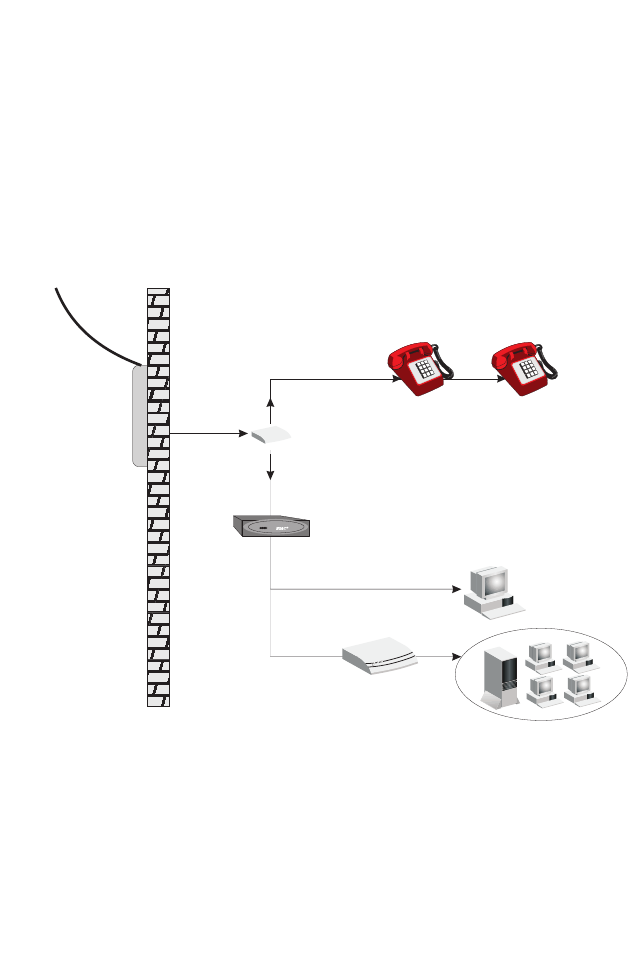
I
NSTALLATION
2-6
signals through but filter data signals out.)
Phone Line Configuration
Installing a Full-rate Connection
If you are using a full-rate (G.dmt) connection, your service provider will
attach the outside ADSL line to a data/voice splitter. In this case you can
connect your phones and computer directly to the splitter as shown below:
Figure 2-1. Installing with a Splitter
Voice
Data
Residential
Connection
Point (NID)
Plain Old
Telephone
System (POTS)
or
Ethernet
hub or switch
ADSL Router
Splitter
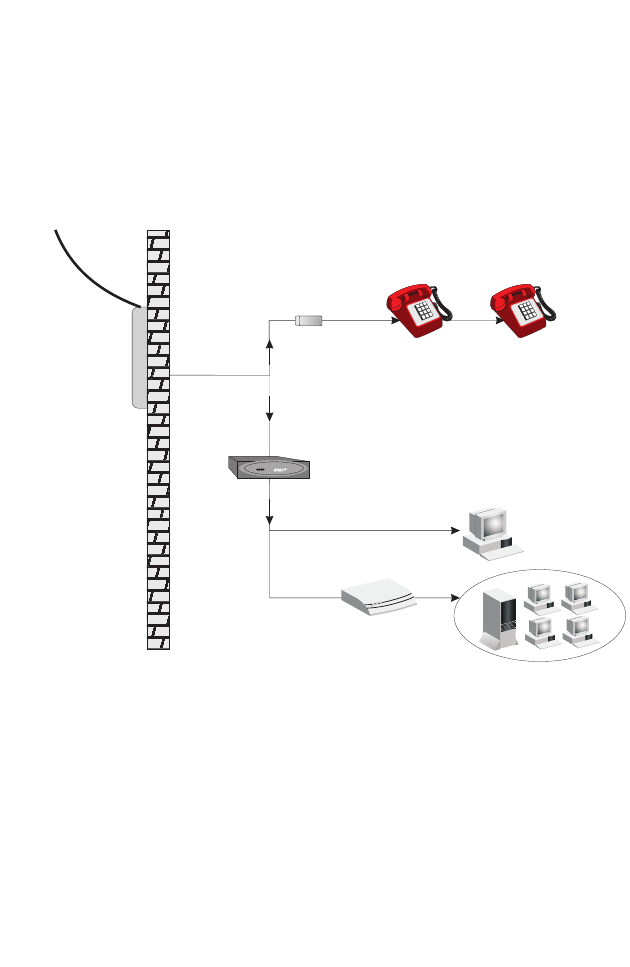
C
ONNECT
THE
S
YSTEM
2-7
Installing a Splitterless Connection
If you are using a splitterless (G.lite) connection, then your service
provider will attach the outside ADSL line directly to your phone system.
In this case you can connect your phones and computer directly to the
incoming ADSL line, but you will have to add low-pass filters to your
phones as shown below:
Figure 2-2. Installing without a Splitter
Attach to Your Network Using Ethernet Cabling
The four LAN ports on the Barricade auto-negotiate the connection speed
to 10 Mbps Ethernet or 100 Mbps Fast Ethernet, as well as the
transmission mode to half duplex or full duplex.
Residential
Connection
Point (NID)
Plain Old
Telephone
System (POTS)
Filter
or
Ethernet
hub or switch
Voice
& Data
Voice
& Data
Data
Voice
ADSL Router

I
NSTALLATION
2-8
Use twisted-pair cabling to connect any of the four LAN ports on the
Barricade to an Ethernet adapter on your PC. Otherwise, cascade any of
the LAN ports on the Barricade to an Ethernet hub or switch, and then
connect your PC or other network equipment to the hub or switch. When
inserting an RJ-45 connector, be sure the tab on the connector clicks into
position to ensure that it is properly seated.
Warning:Do not plug a phone jack connector into an RJ-45 port. This
may damage the Barricade.
Notes: 1. Use 100-ohm shielded or unshielded twisted-pair cable with
RJ-45 connectors for all Ethernet ports. Use Category 3, 4, or 5
for connections that operate at 10 Mbps, and Category 5 for
connections that operate at 100 Mbps.
2.Make sure each twisted-pair cable length does not exceed
100 meters (328 feet).
Connect the Power Adapter
Plug the power adapter into the power socket on the rear of the Barricade,
and the other end into a power outlet.
Check to confirm the power indicator on the front panel is lit. If the power
i
ndicator is not lit, refer to
“Troubleshooting” on page A-1.
In case of a power input failure, the Barricade will automatically restart and
begin to operate once the input power is restored.
If the Barricade is properly configured, it will take about 30 seconds to
establish a connection with the ADSL service provider after powering up.
During this time the Sync indicator will flash. After the ADSL connection
has been established, the ADSL Sync LED will stay on.

3-1
C
HAPTER
3
C
ONFIGURING
C
LIENT
PC
After completing hardware setup by connecting all your network devices,
you need to configure your computer to connect to the Barricade. First
determine how your ISP issues your IP address. Many ISPs issue these
numbers automatically using Dynamic Host Configuration Protocol
(DHCP). Other ISPs provide a static IP address and associated numbers,
which you must enter manually. How your ISP assigns your IP address
determines how you need to configure your computer. See this section for
Windows 95/98/Me configuration. See “Windows NT 4.0” on page 3-8,
“Windows 2000” on page 3-13, “Windows XP” on page 3-17, or
“Configuring Your Macintosh Computer” on page 3-21 depending on
your operating system.
TCP/IP Configuration
To access the Internet through the Barricade, you must configure the
network settings of the computers on your LAN to use the same IP subnet
as the Barricade. The default network settings for the Barricade are:
IP Address: 192.168.2.1
Subnet Mask: 255.255.255.0
Note: These settings can be changed to fit your network requirements,
but you must first configure at least one computer to access the
Barricade’s Web configuration interface in order to make the
required changes. (See “Configuring the Barricade” on page 4-1
for instruction on configuring the Barricade.)
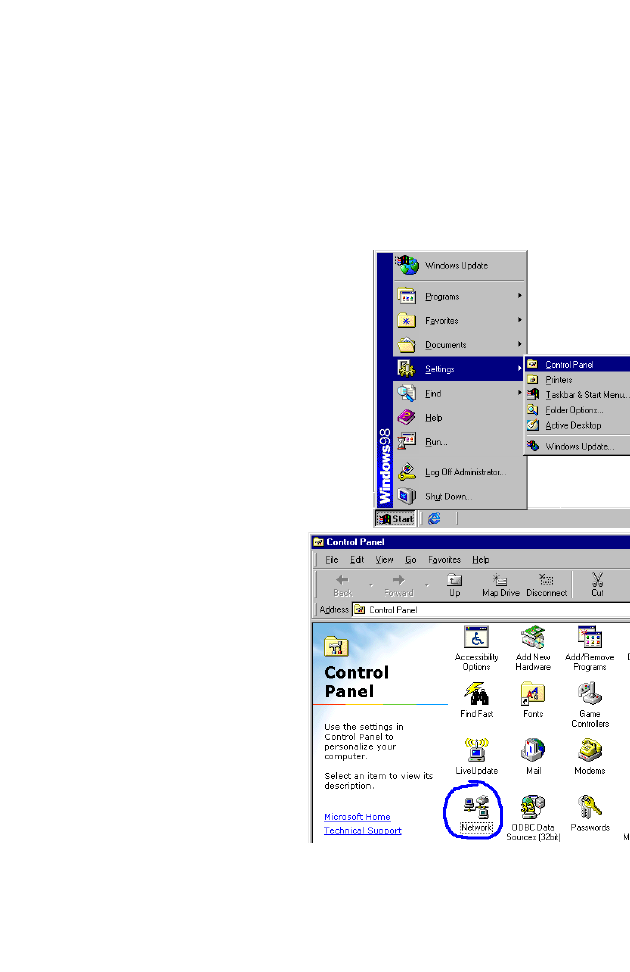
C
ONFIGURING
C
LIENT
PC
3-2
Windows 95/98/Me
You may find that the instructions in this section do not exactly match
your version of Windows. This is because these steps and screenshots were
created from Windows 98. Windows 95 and Windows Millennium Edition
are similar, but not identical, to Windows 98.
1. On the Windows desktop,
click Start/Settings/Control Panel.
2. In Control Panel,
double-click the Network
icon.
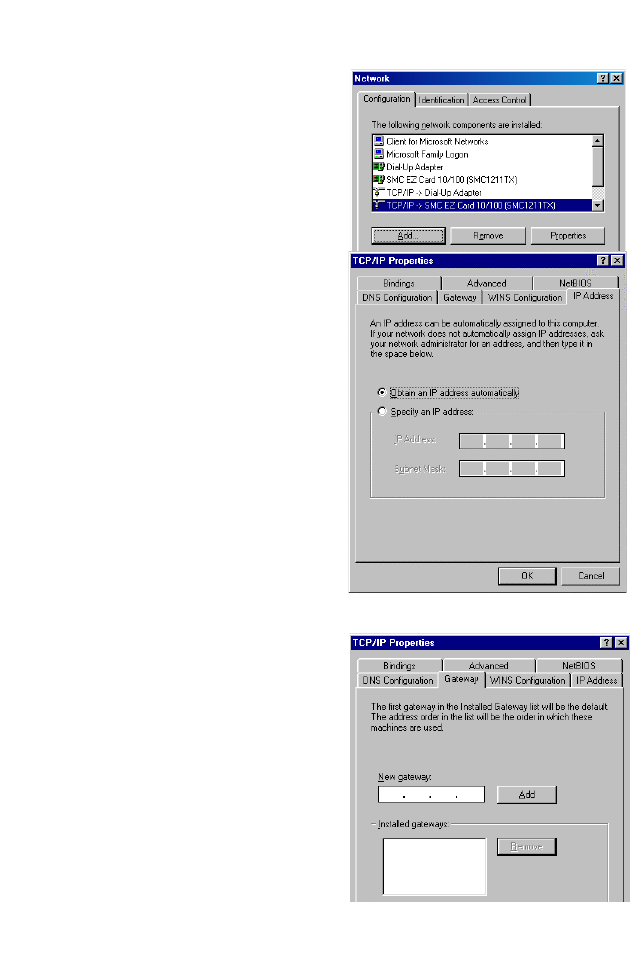
W
INDOWS
95/98/M
E
3-3
3. In the Network window, under
the Configuration tab,
double-click the TCP/IP item
listed for your network card.
4. In the TCP/IP window, select
the IP Address tab. If “Obtain
an IP address automatically” is
already selected, your
computer is already configured
for DHCP. Click Cancel to
close each window, and skip to
“Disable HTTP Proxy” on
page 3-5. If not, locate your IP
address and subnet mask.
Record the numbers in the
space provided on the
following page.
5. Click the Gateway tab and
record the numbers listed
under the Installed gateways
field.
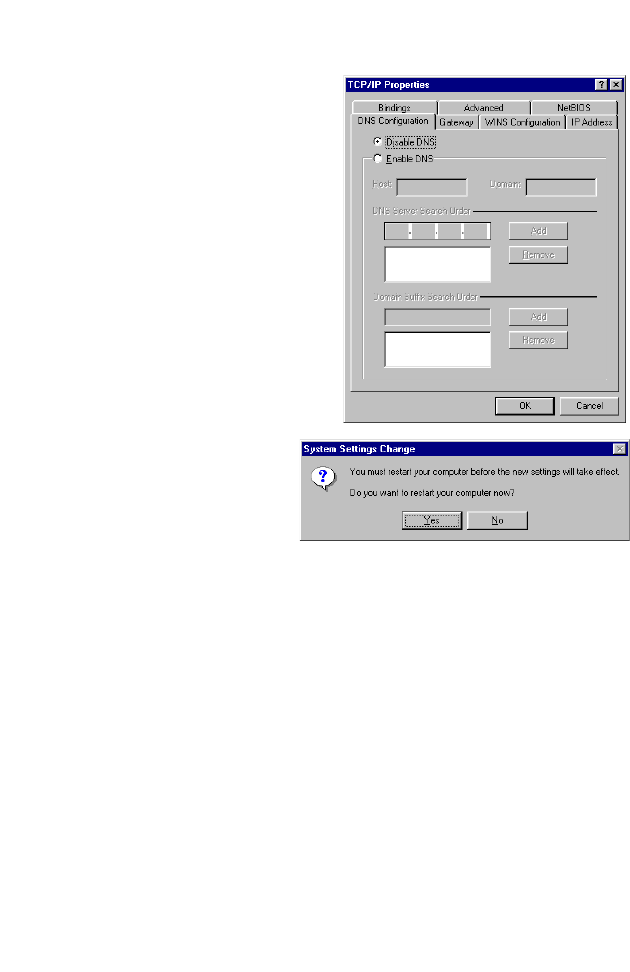
C
ONFIGURING
C
LIENT
PC
3-4
6. Click the DNS
Configuration tab. Locate
the DNS servers listed
under the DNS Server
Search Order field. Record
any listed addresses.
7. After writing down your
settings, check to make sure
you have recorded them
correctly. Click OK to close
the window.
8. Windows may need your
Windows 95/98/Me CD
to copy some files. After
it finishes copying, it will
prompt you to restart
your system. Click Yes and your computer will shut down and restart.
TCP/IP Configuration Setting
IP Address ____.____.____.____
Subnet Mask ____.____.____.____
Primary DNS Server ____.____.____.____
Secondary DNS Server ____.____.____.____
Default Gateway ____.____.____.____
Host Name ____.____.____.____
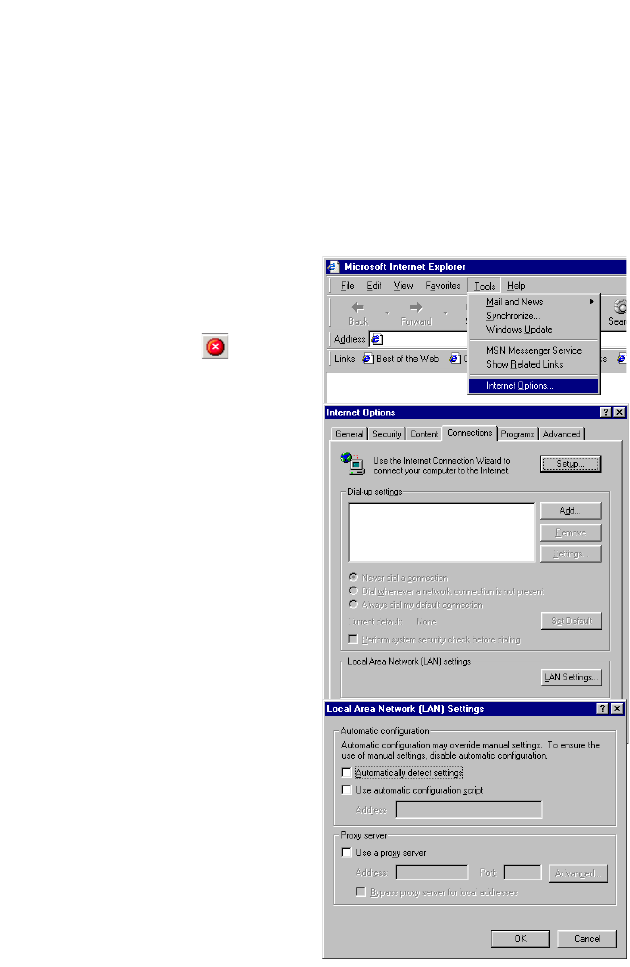
W
INDOWS
95/98/M
E
3-5
Disable HTTP Proxy
You need to verify that the “HTTP Proxy” feature of your Web browser is
disabled. This is so that your browser can view the Barricade’s HTML
configuration pages. The following steps are for Internet Explorer and
Netscape. Determine which browser you use and follow the appropriate
steps.
Internet Explorer
1. Open Internet Explorer.
2. Click the Stop button,
then click Tools/Internet
Options.
3. In the Internet Options
window, click the
Connections tab. Next, click
the LAN Settings... button.
4. Clear all the checkboxes.
5. Click OK, and then click
OK again to close the
Internet Options window.
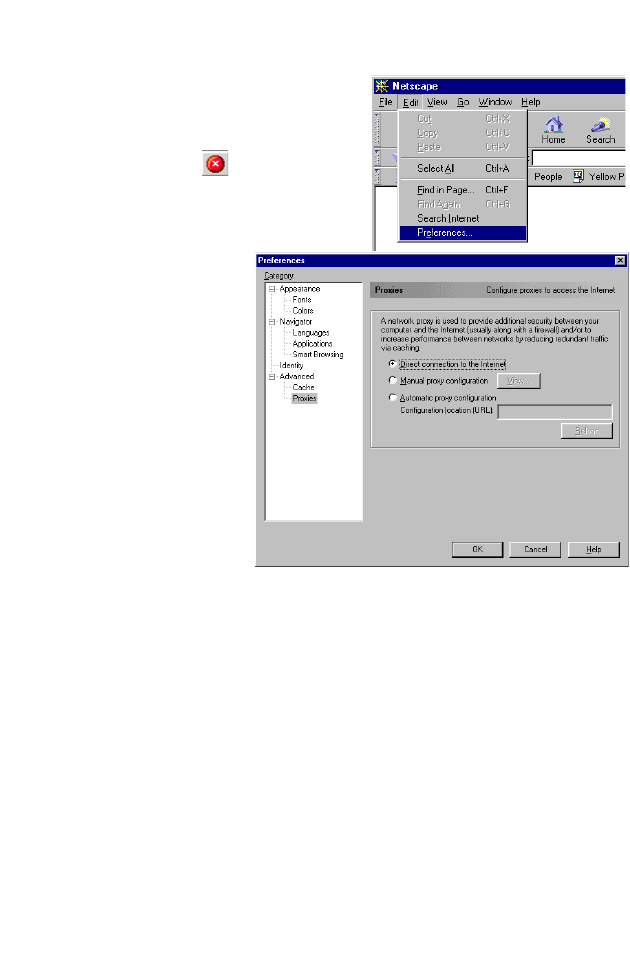
C
ONFIGURING
C
LIENT
PC
3-6
Netscape
1. Open Netscape.
2. Click the Stop button, and
then click Edit/Preferences...
3. In the Preferences
window, under the
Category field
double-click
Advanced, then click
Proxies. Select
“Direct connection
to the Internet.”
Click OK.
4. Repeat these steps
for each Windows
95/98/Me computer
connected to your Barricade.
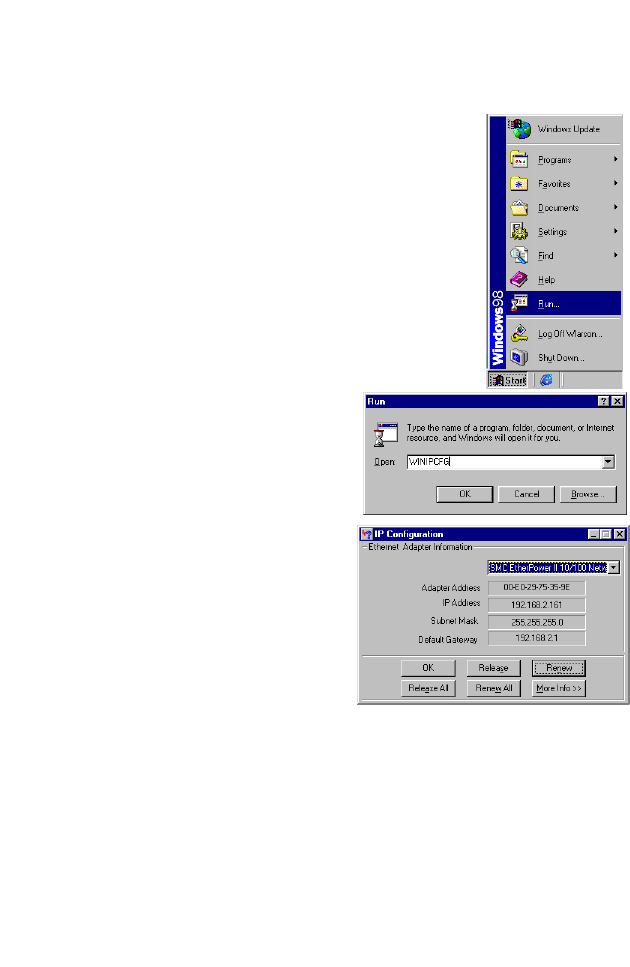
W
INDOWS
95/98/M
E
3-7
Obtain IP Settings from Your ADSL Router
Now that you have configured your computer to
connect to your Barricade, it needs to obtain new
network settings. By releasing old DHCP IP settings
and renewing them with settings from your Barricade,
you can also verify that you have configured your
computer correctly.
1. On the Windows desktop, click Start/Run...
2. Type “WINIPCFG” and click OK.
It may take a second or two for the
IP Configuration window to
appear.
3. In the IP Configuration window,
select your network card from the
drop-down menu. Click Release
and then click Renew. Verify that
your IP address is now
192.168.2.xxx, your Subnet
Mask is 255.255.255.0 and your
Default Gateway is 192.168.2.1.
These values confirm that your Barricade is functioning. Click OK to
close the IP Configuration window.
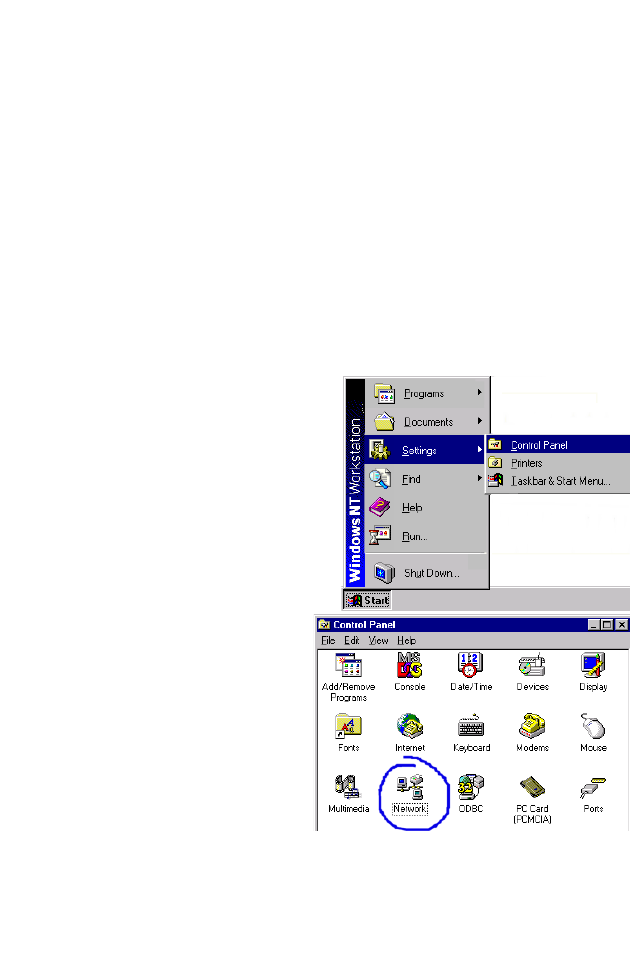
C
ONFIGURING
C
LIENT
PC
3-8
Windows NT 4.0
After completing the hardware setup by connecting your network devices,
you need to configure your computer to connect to the Barricade. First
determine how your ISP issues your IP address. Many ISPs issue these
numbers automatically using Dynamic Host Configuration Protocol
(DHCP). Other ISPs provide a static IP address and associated numbers,
which you must enter manually. How your ISP assigns your IP address
determines how you need to configure your computer.
Follow these instructions:
1. On the Windows desktop,
click Start/Settings/Control
Panel.
2. Double-click the Network
icon.
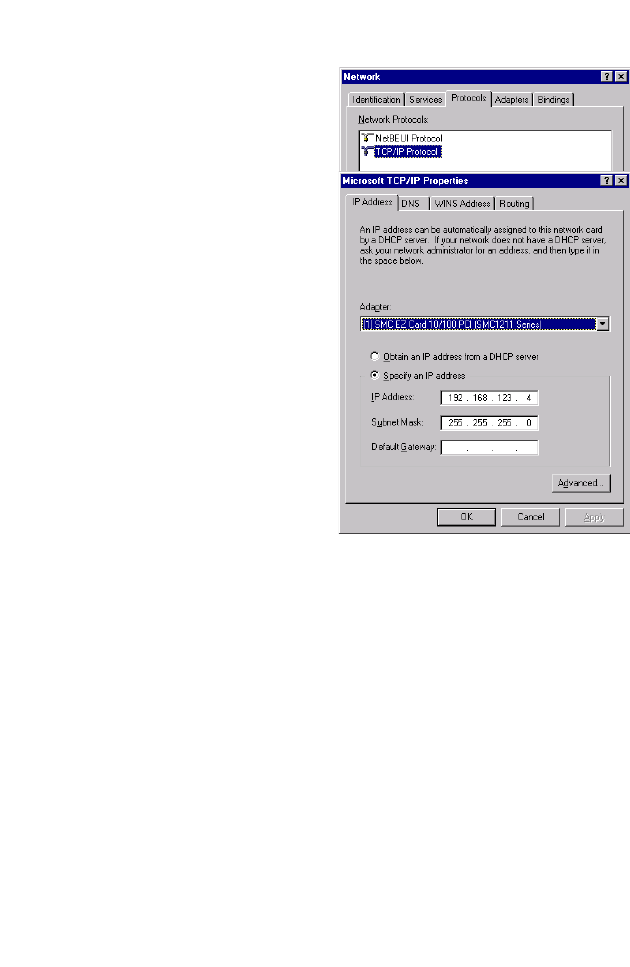
W
INDOWS
NT 4.0
3-9
3. In the Network window,
Select the Protocols tab.
Double-click TCP/IP
Protocol.
4. When the Microsoft TCP/IP
Properties window open,
select the IP Address tab.
5. In the Adapter drop-down
list, be sure your Ethernet
adapter is selected.
6. If “Obtain an IP address
automatically” is already
selected, your computer is
already configured for
DHCP. Click Cancel to close
each window, and skip to
“Disable HTTP Proxy” on
page 3-10.
7. In the TCP/IP Properties window, under the IP Address tab, locate
your IP Address, Subnet Mask, and Default Gateway. Record these
values in the spaces provided on the following page.
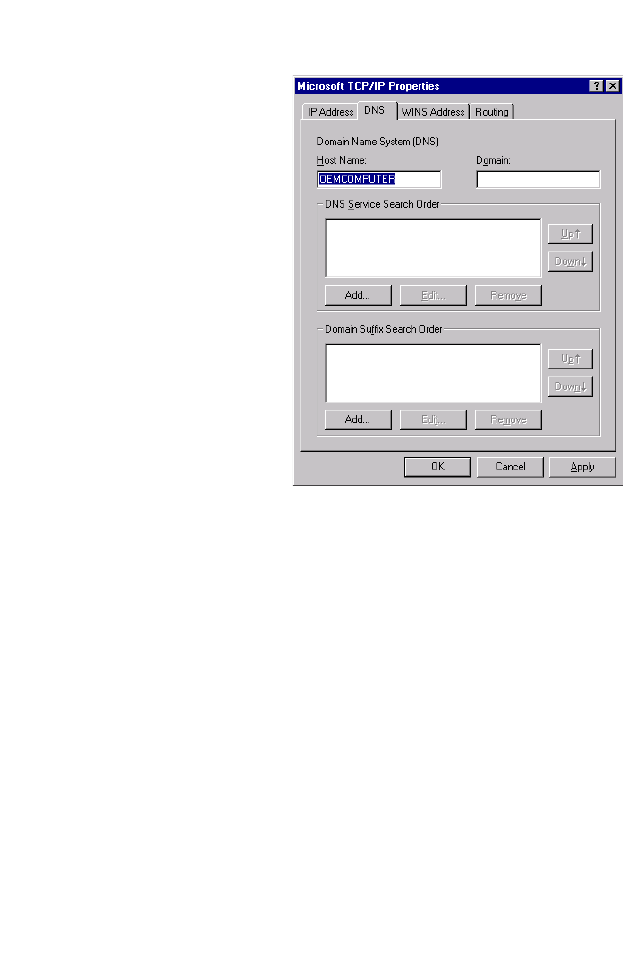
C
ONFIGURING
C
LIENT
PC
3-10
8. Click the DNS tab to see
the primary and
secondary DNS servers.
Record these values in
the spaces provided
below.
9. After writing down your
IP settings, click the IP
address tab. Select the
Obtain IP address
automatically radio
button and click OK.
Click OK again to close
the Network window.
10. Windows may copy some files, and will then prompt you to restart
your system. Click Yes and your computer will shut down and restart.
Disable HTTP Proxy
You need to verify that the “HTTP Proxy” feature of your Web browser is
disabled. This is so that your browser can view the Barricade’s HTML
configuration pages. Determine which browser you use and refer to
“Internet Explorer” on page 3-5 or “Netscape” on page 3-6.
TCP/IP Configuration Setting
IP Address ____.____.____.____
Subnet Mask ____.____.____.____
Default Gateway ____.____.____.____
Primary DNS Server ____.____.____.____
Secondary DNS Server ____.____.____.____
Host Name ____.____.____.____
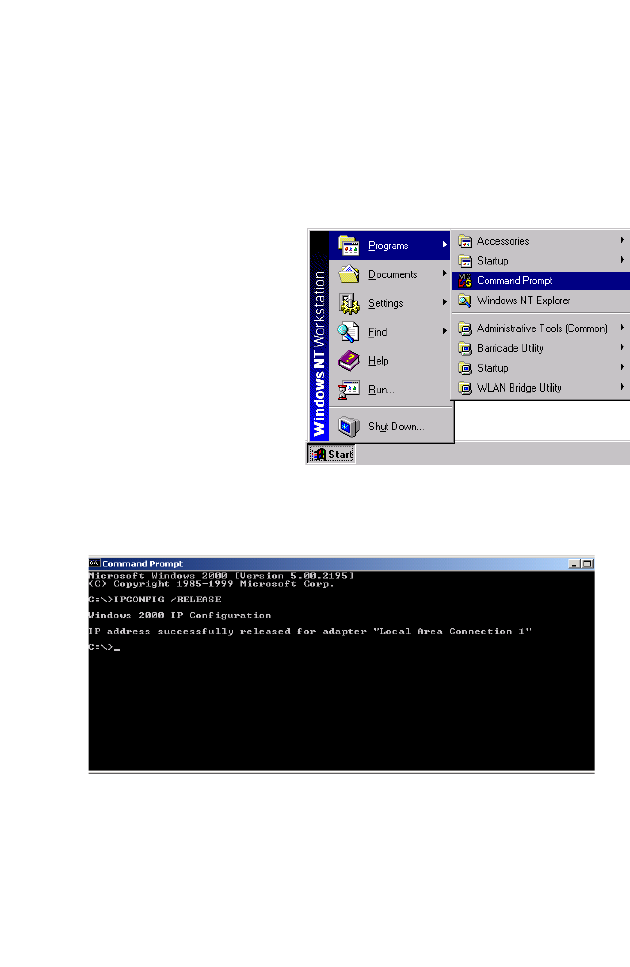
W
INDOWS
NT 4.0
3-11
Obtain IP Settings from Your Barricade
Now that you have configured your computer to connect to your
Barricade, it needs to obtain new network settings. By releasing old DHCP
IP settings and renewing them with settings from your Barricade, you will
verify that you have configured your computer correctly.
1. On the Windows desktop,
click Start/Programs/
Command Prompt.
2. In the Command Prompt window, type “IPCONFIG /RELEASE”
and press the ENTER key.
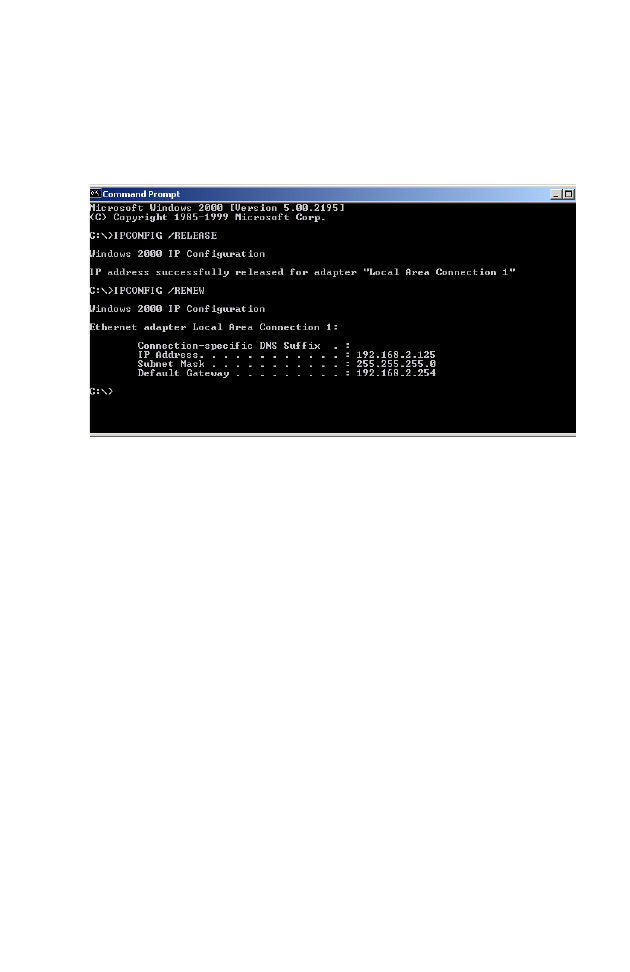
C
ONFIGURING
C
LIENT
PC
3-12
3. Type “IPCONFIG /RENEW” and press the ENTER key. Verify that
your IP Address is now 192.168.2.xxx, your Subnet Mask is
255.255.255.0 and your Default Gateway is 192.168.2.1. These
values confirm that your Barricade is functioning.
4. Type “EXIT” and press the ENTER key to close the Command
Prompt window.
Your computer is now configured to connect to the Barricade.
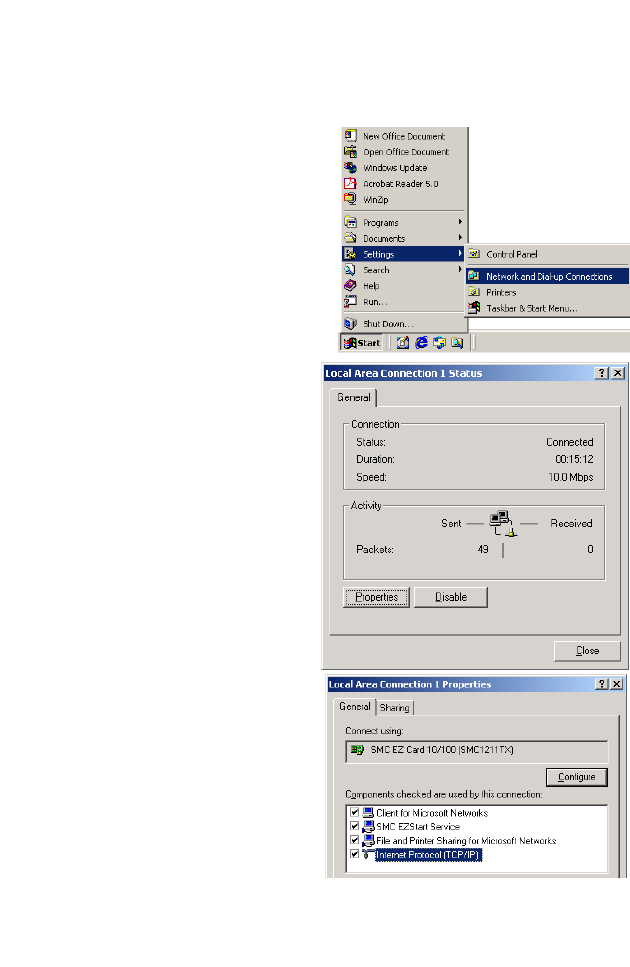
W
INDOWS
2000
3-13
Windows 2000
1. On the Windows desktop,
click Start/Settings/
Network and Dial-Up
Connections.
2. Click the icon that
corresponds to the
connection to your
Barricade.
3. The connection status
screen will open. Click
Properties.
4. Double-click Internet
Protocol (TCP/IP).
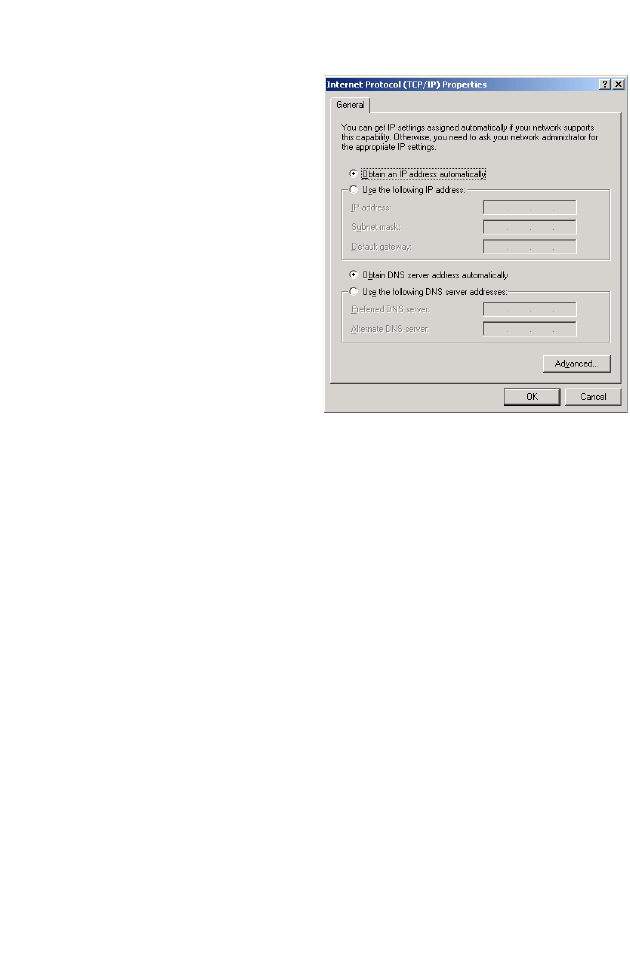
C
ONFIGURING
C
LIENT
PC
3-14
5. If there is IP Address
information on the Internet
Protocol (TCP/IP)
Properties window, it
should be recorded. Use the
spaces below to record the
current settings.
6. If “Obtain an IP address
automatically” and “Obtain
DNS server address
automatically” are already
selected, your computer is
already configured for
DHCP. Click Cancel to close each window, and skip to “Disable
HTTP Proxy” on page 3-14.
7. Select “Obtain an IP address automatically” and “Obtain DNS server
address automatically.” Click OK or Close to close each window.
Disable HTTP Proxy
You need to verify that the “HTTP Proxy” feature of your Web browser is
disabled. This is so that your browser can view the Barricade’s HTML
configuration pages. Determine which browser you use and refer to
“Internet Explorer” on page 3-5 or “Netscape” on page 3-6.
TCP/IP Configuration Setting
IP Address ____.____.____.____
Subnet Mask ____.____.____.____
Default Gateway ____.____.____.____
Preferred DNS Server ____.____.____.____
Alternate DNS Server ____.____.____.____
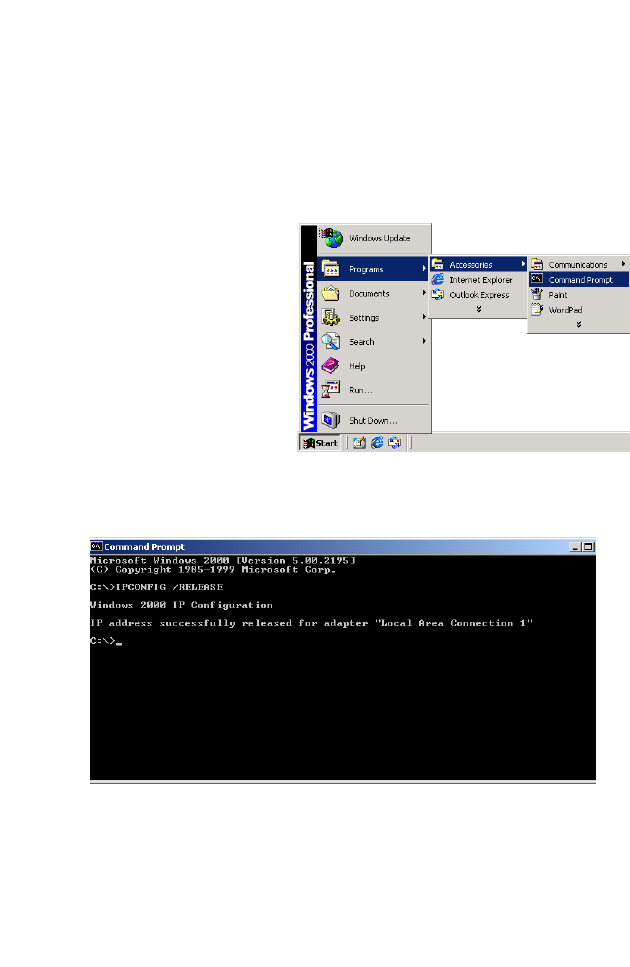
W
INDOWS
2000
3-15
Obtain IP Settings from Your Barricade
Now that you have configured your computer to connect to your
Barricade, it needs to obtain new network settings. By releasing old DHCP
IP settings and renewing them with settings from your Barricade, you can
verify that you have configured your computer correctly.
1. On the Windows desktop,
click Start/Programs/
Accessories/Command
Prompt.
2. In the Command Prompt window, type “IPCONFIG/RELEASE”
and press the ENTER key.
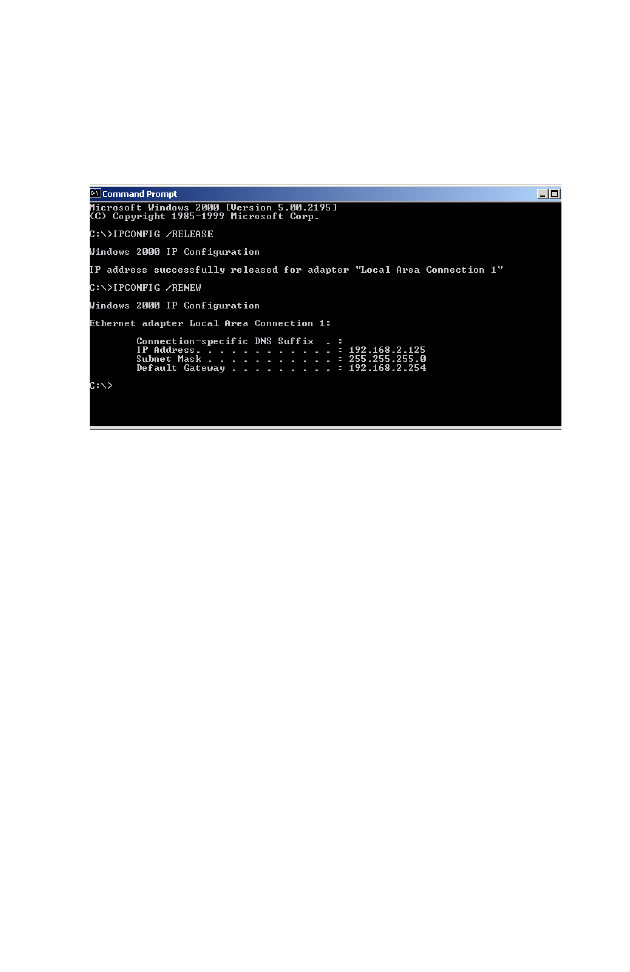
C
ONFIGURING
C
LIENT
PC
3-16
3. Type “IPCONFIG /RENEW” and press the ENTER key. Verify that
your IP Address is now 192.168.2.xxx, your Subnet Mask is
255.255.255.0 and your Default Gateway is 192.168.2.1. These
values confirm that your ADSL Router is functioning.
4. Type “EXIT” and press the ENTER key to close the Command
Prompt window.
Your computer is now configured to connect to the Barricade.
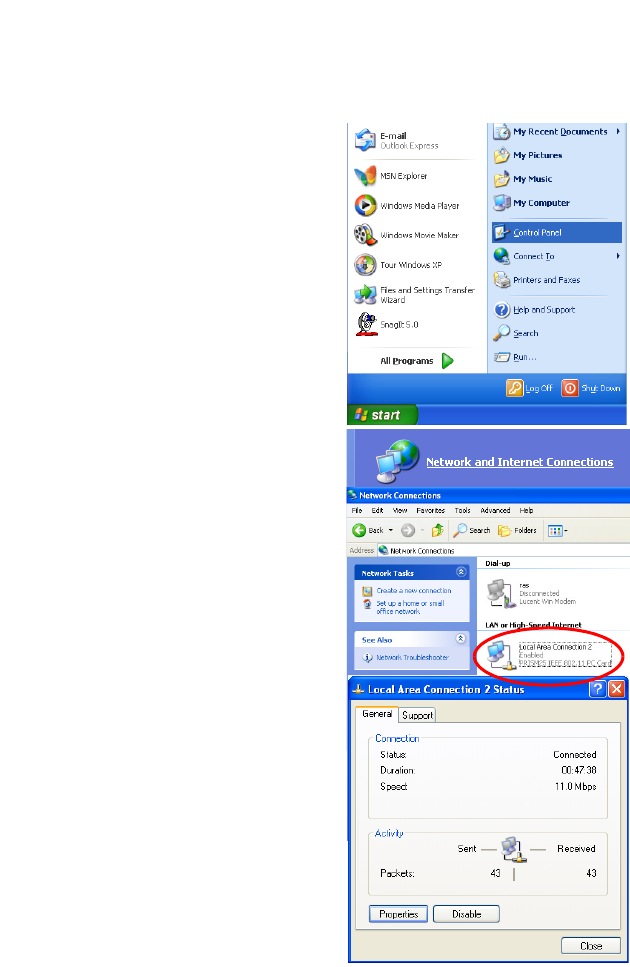
W
INDOWS
XP
3-17
Windows XP
1. On the Windows desktop,
click Start/Control Panel.
2. In the Control Panel window,
click Network and Internet
Connections.
3. The Network Connections
window will open. Double-click
the connection for this device.
4. On the connection status screen,
click Properties.
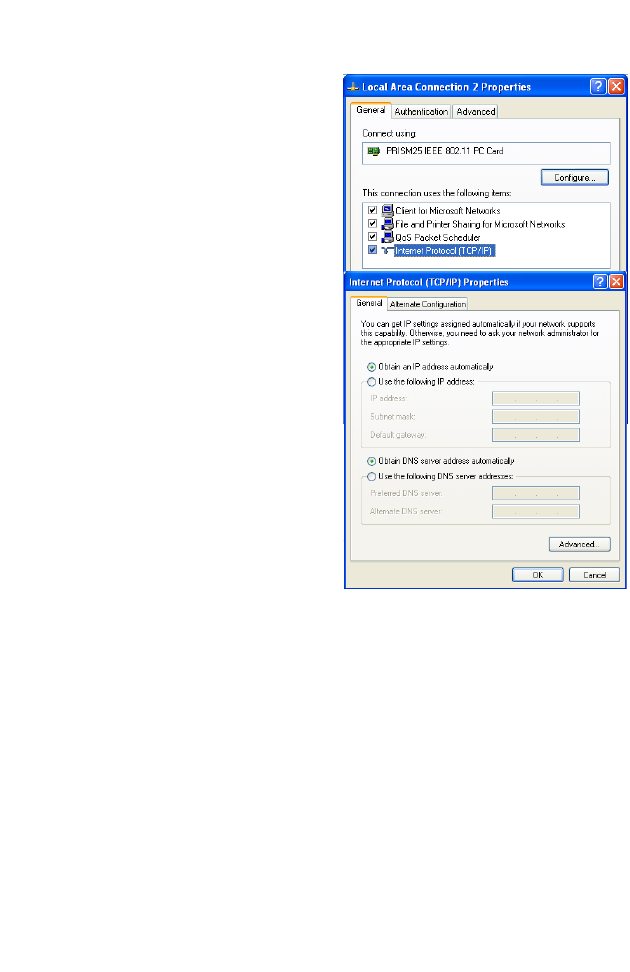
C
ONFIGURING
C
LIENT
PC
3-18
5. Double-click Internet
Protocol (TCP/IP).
6. If there is IP Address
information on the Internet
Protocol (TCP/IP) Properties
window, it should be
recorded. Use the spaces
below to record the current
settings.
7. If “Obtain an IP address
automatically” and “Obtain
DNS server address
automatically” are already
selected, your computer is
already configured for DHCP. Click Cancel to close each window, and
skip to “Disable HTTP Proxy” on page 3-19.”
8. Select “Obtain an IP address automatically” and “Obtain DNS server
address automatically.” Click OK or Close to close each window.
TCP/IP Configuration Setting
IP Address ____.____.____.____
Subnet Mask ____.____.____.____
Default Gateway ____.____.____.____
Preferred DNS Server ____.____.____.____
Alternate DNS Server ____.____.____.____
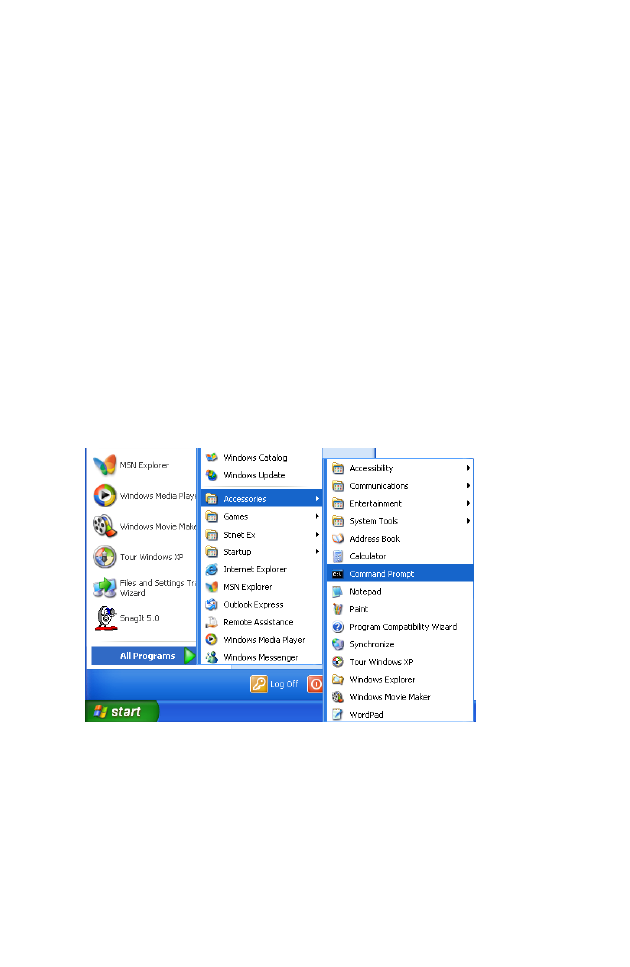
W
INDOWS
XP
3-19
Disable HTTP Proxy
You need to verify that the “HTTP Proxy” feature of your Web browser is
disabled. This is so that your browser can view the Barricade’s HTML
configuration pages. Determine which browser you use and refer to
“Internet Explorer” on page 3-5 or “Netscape” on page 3-6.
Obtain IP Settings from Your Barricade
Now that you have configured your computer to connect to your
Barricade, it needs to obtain new network settings. By releasing old DHCP
IP settings and renewing them with settings from your Barricade, you can
verify that you have configured your computer correctly.
1. On the Windows desktop, click Start/Programs/Accessories/
Command Prompt.
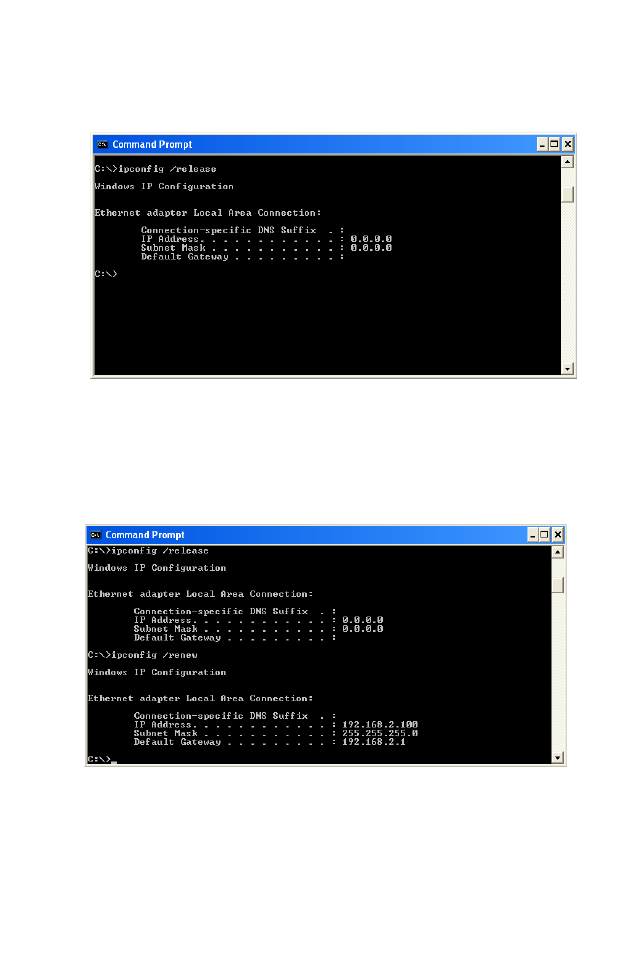
C
ONFIGURING
C
LIENT
PC
3-20
2. In the Command Prompt window, type “IPCONFIG/RELEASE”
and press the ENTER key.
3. Type “IPCONFIG /RENEW” and press the ENTER key. Verify that
your IP Address is now 192.168.2.xxx, your Subnet Mask is
255.255.255.0 and your Default Gateway is 192.168.2.1. These
values confirm that your ADSL Router is functioning.
Type “EXIT” and press the ENTER key to close the Command Prompt
window.
Your computer is now configured to connect to the Barricade.
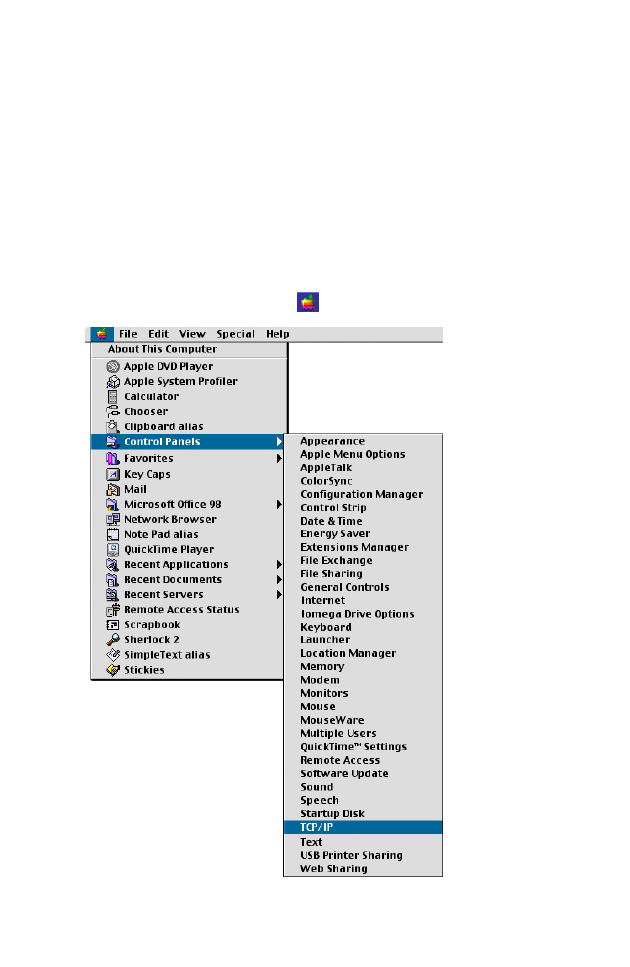
C
ONFIGURING
Y
OUR
M
ACINTOSH
C
OMPUTER
3-21
Configuring Your Macintosh Computer
You may find that the instructions here do not exactly match your
operating system. This is because these steps and screenshots were created
using Mac OS 8.5. Mac OS 7.x and above are similar, but may not be
identical to Mac OS 8.5.
Follow these instructions:
1. Pull down the Apple Menu . Click Control Panels/TCP/IP.
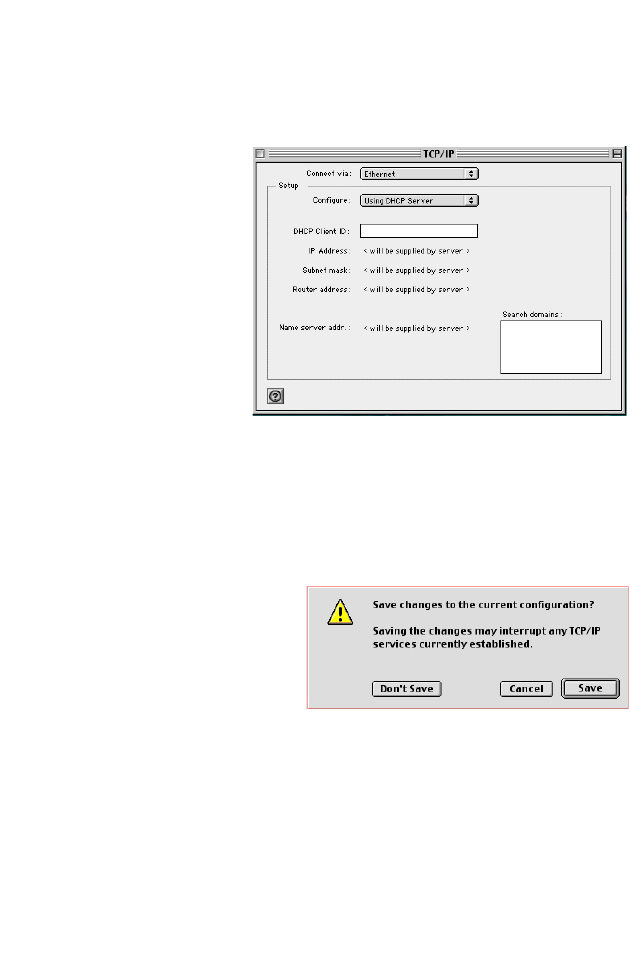
C
ONFIGURING
C
LIENT
PC
3-22
2. In the TCP/IP window, make sure “Ethernet” is selected in the
Connect via: field.
3. If “Using DHCP
Server” is already
selected in the
Configure field, your
computer is already
configured for
DHCP. Close the
TCP/IP window,
and skip to “Disable
HTTP Proxy” on
page 3-23.
4. If there is IP Address information on the TCP/IP screen, it should be
recorded. Use the spaces below to record the current settings.
5. After writing down your IP settings, select “Using DHCP Server” in
the Configure field and close the window.
6. Another box will appear
asking whether you want to
save your settings. Click
Save.
TCP/IP Configuration Setting
IP Address ____.____.____.____
Subnet mask ____.____.____.____
Router address ____.____.____.____
Name server address ____.____.____.____
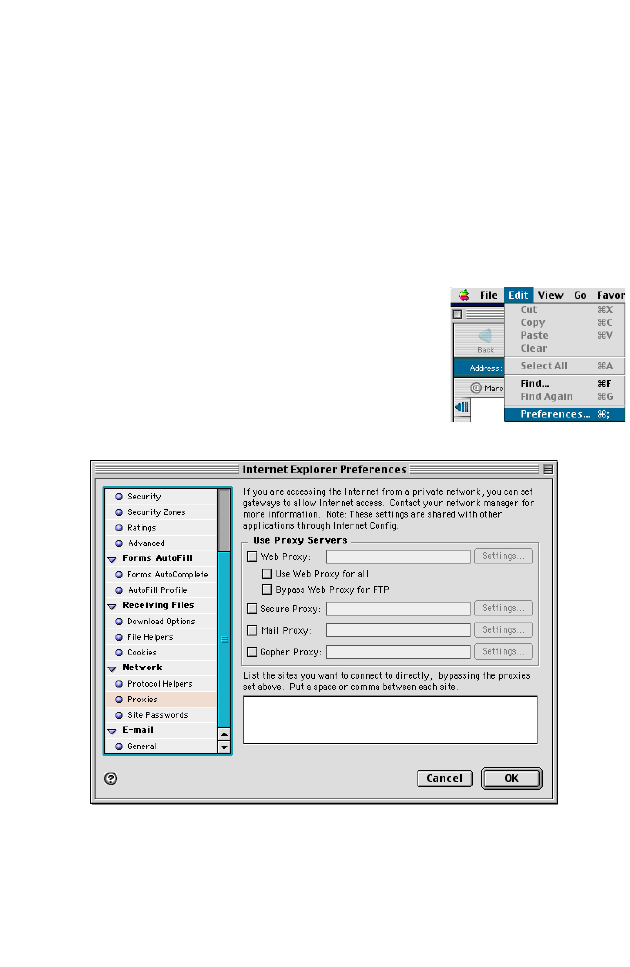
C
ONFIGURING
Y
OUR
M
ACINTOSH
C
OMPUTER
3-23
Disable HTTP Proxy
You need to verify that the “HTTP Proxy” feature of your Web browser is
disabled. This is so that your browser can view the Barricade’s HTML
configuration pages. The following steps are for Internet Explorer and
Netscape. Determine which browser you use and follow the appropriate
steps.
Internet Explorer
1. Open Internet Explorer and click the Stop
button. Click Edit/Preferences.
2. In the Internet Explorer Preferences window,
under Network, select Proxies.
3. Uncheck all checkboxes and click OK.
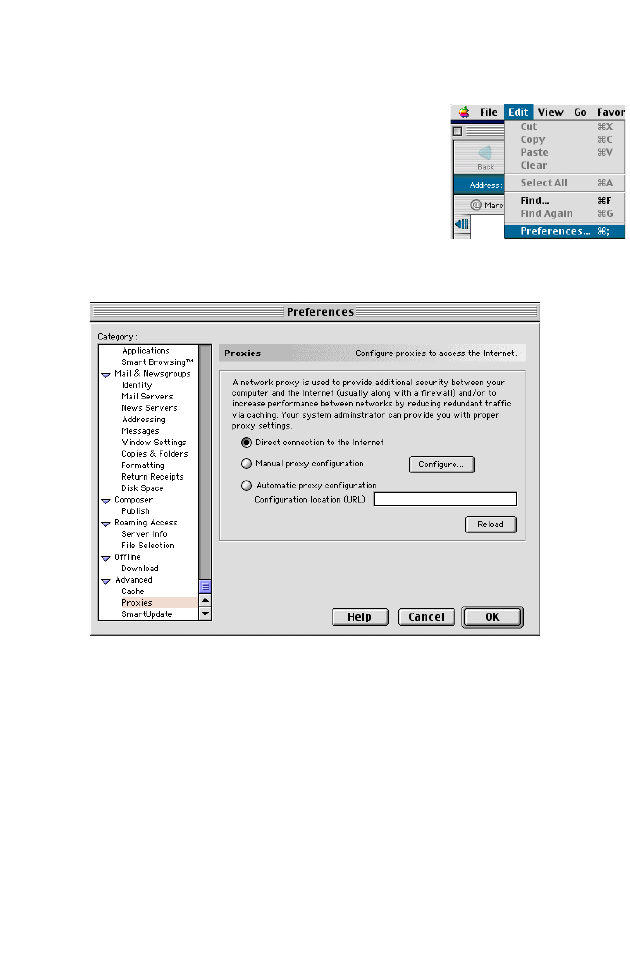
C
ONFIGURING
C
LIENT
PC
3-24
Netscape
1. Open Netscape and click the Stop button.
Click Edit/Preferences.
2. In the Preferences window, in the left-hand
column labeled Category, select Advanced.
Under the Advanced category, select Proxies.
3. Select “Direct Connection to the Internet” and click OK.
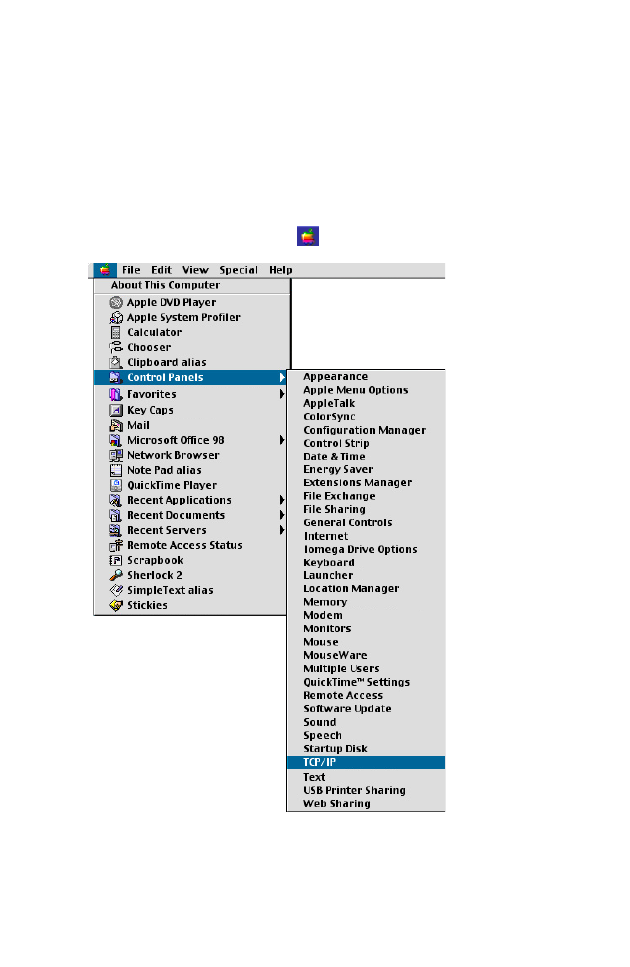
C
ONFIGURING
Y
OUR
M
ACINTOSH
C
OMPUTER
3-25
Obtain IP Settings from Your Barricade
Now that you have configured your computer to connect to your
Barricade, it needs to obtain new network settings. By releasing old DHCP
IP settings and renewing them with settings from your Barricade, you can
verify that you have configured your computer correctly.
1. Pull down the Apple Menu . Click Control Panels/TCP/IP.